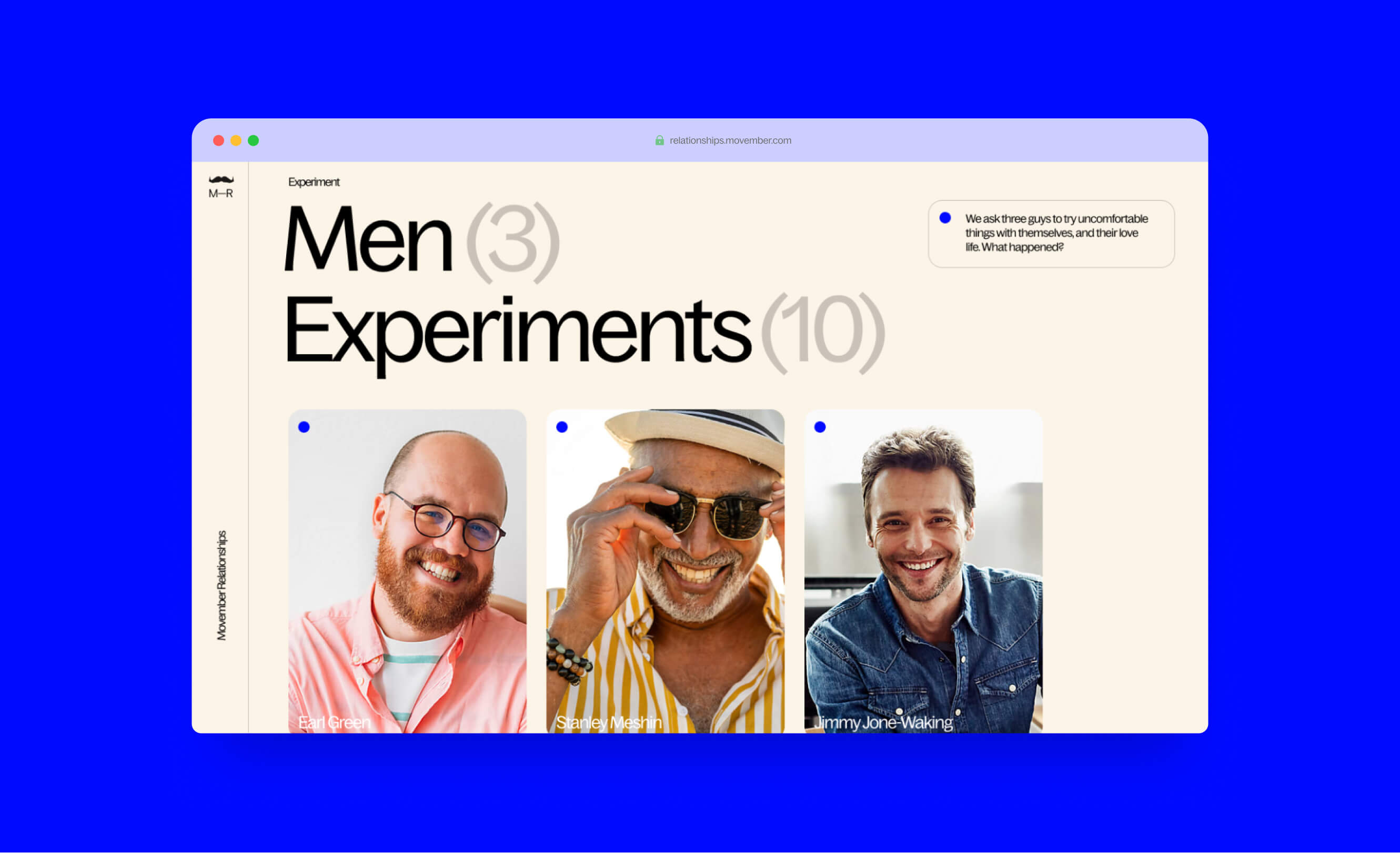Product research, impact, and design case study
I worked with Movember to develop the first brand product built from scratch with a team of researchers, focusing on intimate partner relationships.

Movember had conducted research with the University of British Colombia, focusing on the impact of separation on men. Studies showed that men were more likely than women to suicide following a separation, leading to a focus on intimate partner relationships. I dissected the work to understand what was missing from the narrative, who we were hoping to target, where we could start on the journey from single to separation, how we learn to create meaningful relationships, which behavioral changes and interventions are required to reduce negative mental health outcomes, what it might look like if we did, and how we might engage men in this.
This project was intended to develop upstream relationship skills rather than address downstream challenges such as domestic violence, and therefore does not deal with this. Images from participant quotes are shown with stock photography without names to protect anonymity. Any videos or quotes by known men were used for specific examples during our project work and are not an endorsement of this person as a role model nor a healthy example. Studies in this space can often be small and we place them in context with selection factors, other studies, and society. If you're working in this space with younger men I'd love to hear how you're approaching this, urgent work is needed.
2021 to 2022
Scope
I joined the project as the academic research papers were published to transform the learnings into a product with real-world applicability.
Role
Creating, undertaking and managing the research and product across numerous teams, working with an awesome Product Director.
Outcome
Developed audience, aligned product with internal goals, created comprehensive strategy, turned academic research into useful content, launched an inclusive MVP, outlined impact pathway, significant user research insights.
Audience
Men of all cultures and backgrounds in varying relationship configurations, loosely between 26 and 44, in predominantly anglophone countries.
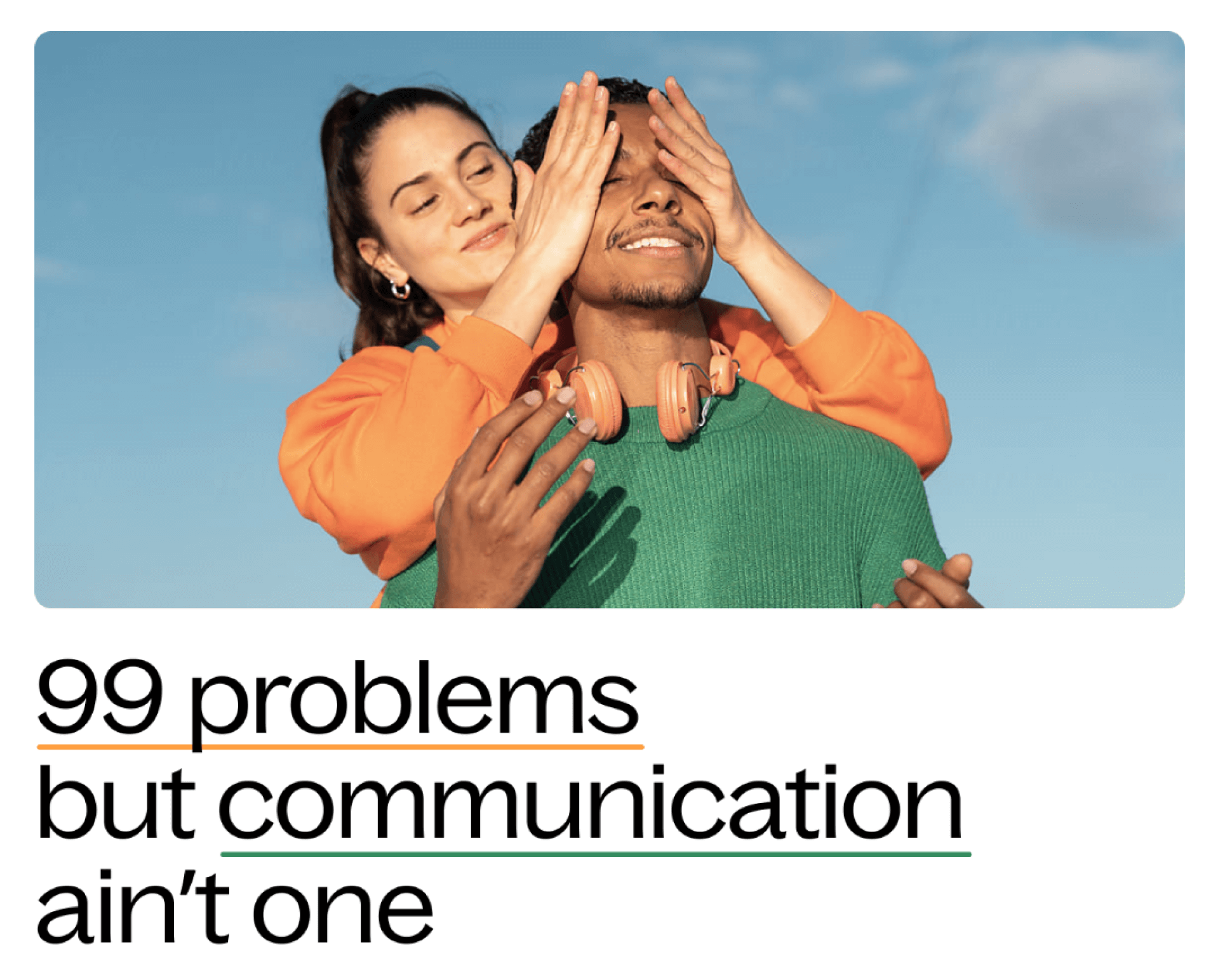
Talking to men
I recruited and spoke to a wide range of men, ensuring we included various faiths, relationships structures, sexual orientation, economic situations, and jobs. I was buoyed by these interviews. They were deeply impactful, vulnerable, and showed that nearly all the men I spoke to valued their partner relationships from various angles. Unlike many women who have social circles that regularly talk about relationships, men in general have fewer networks and communication skills in respect to this. While it appeared to be progressing, our society has reinforced these structures. I was able to gain valuable insights, identify common trends, eliminate a number of existing hypotheses, and develop a report on the findings and how they were placed, and could be understood, in conjunction the academic research. This work also allowed us to distinguish a few clear patterns between dating, relationships, separation, and singleness.
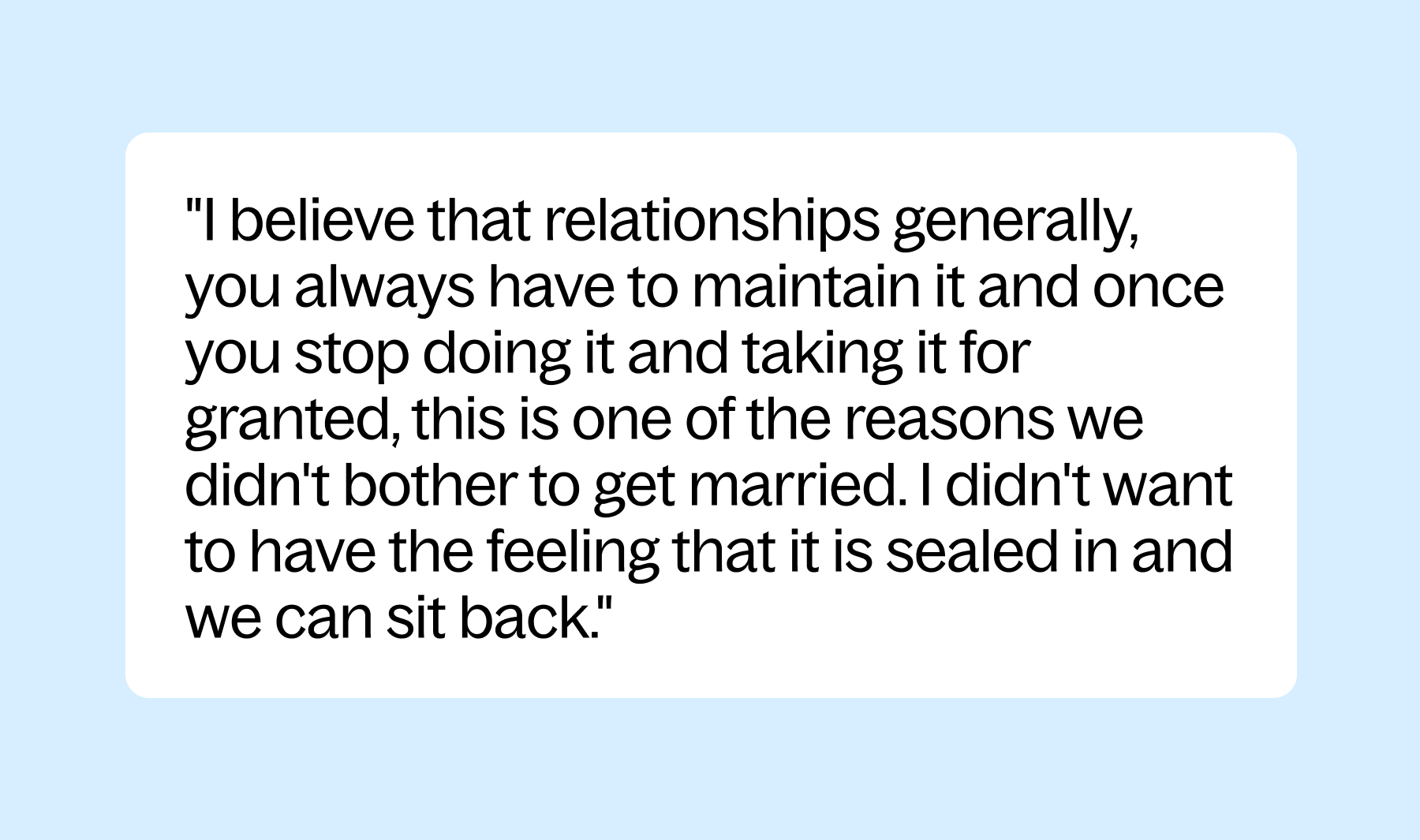

Working out what men have in mind
From the research I built an empathy map to share with our team and researchers, which would give us one of the bricks of our growing foundation. Additionally, I used this as a chance to get the wider organization concentrated on how men were feeling (in general), and what we were trying to solve for. To aid this, I whipped up some desktop wallpapers and quotes with key lines from the research as gentle reminders.
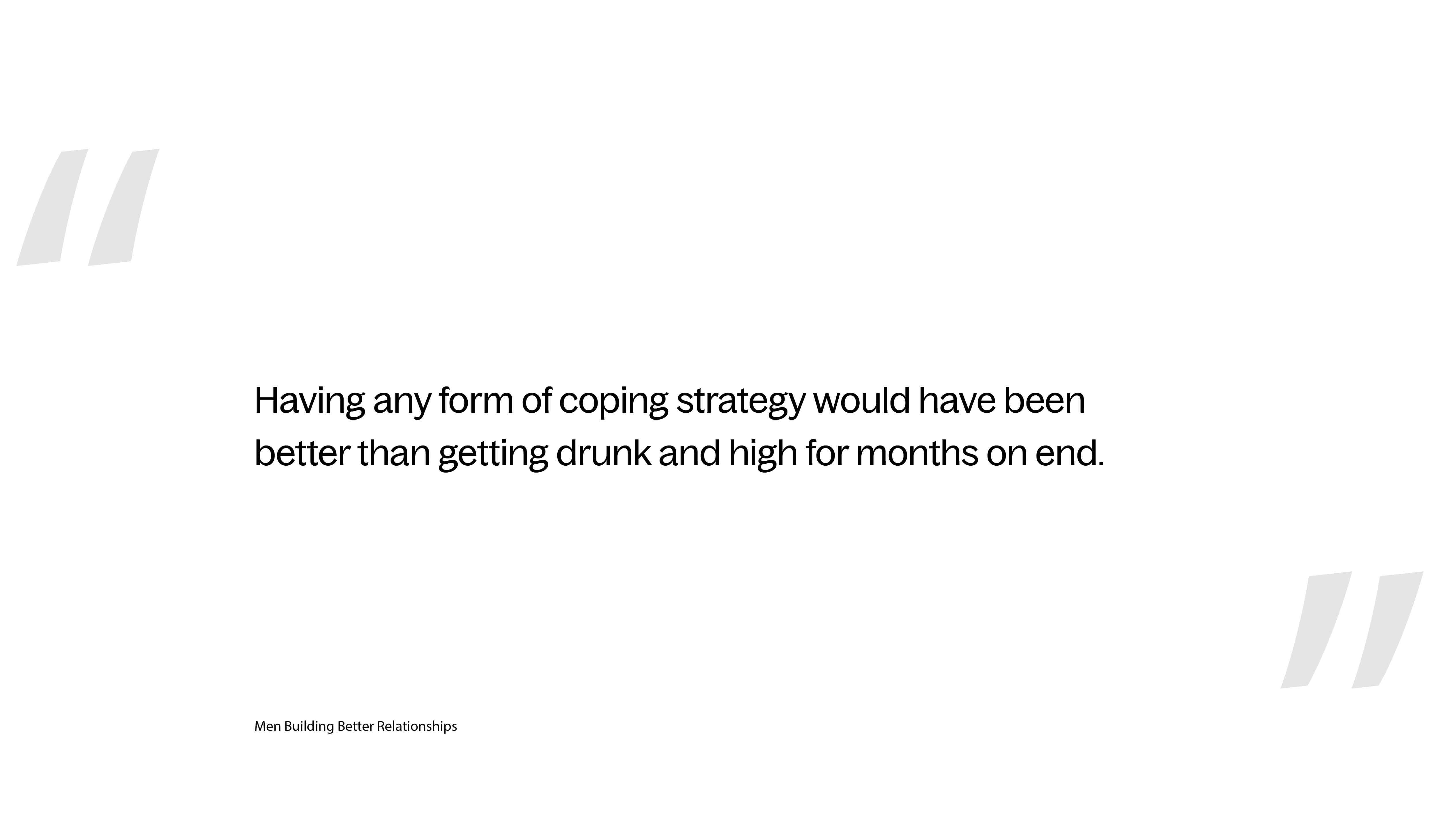
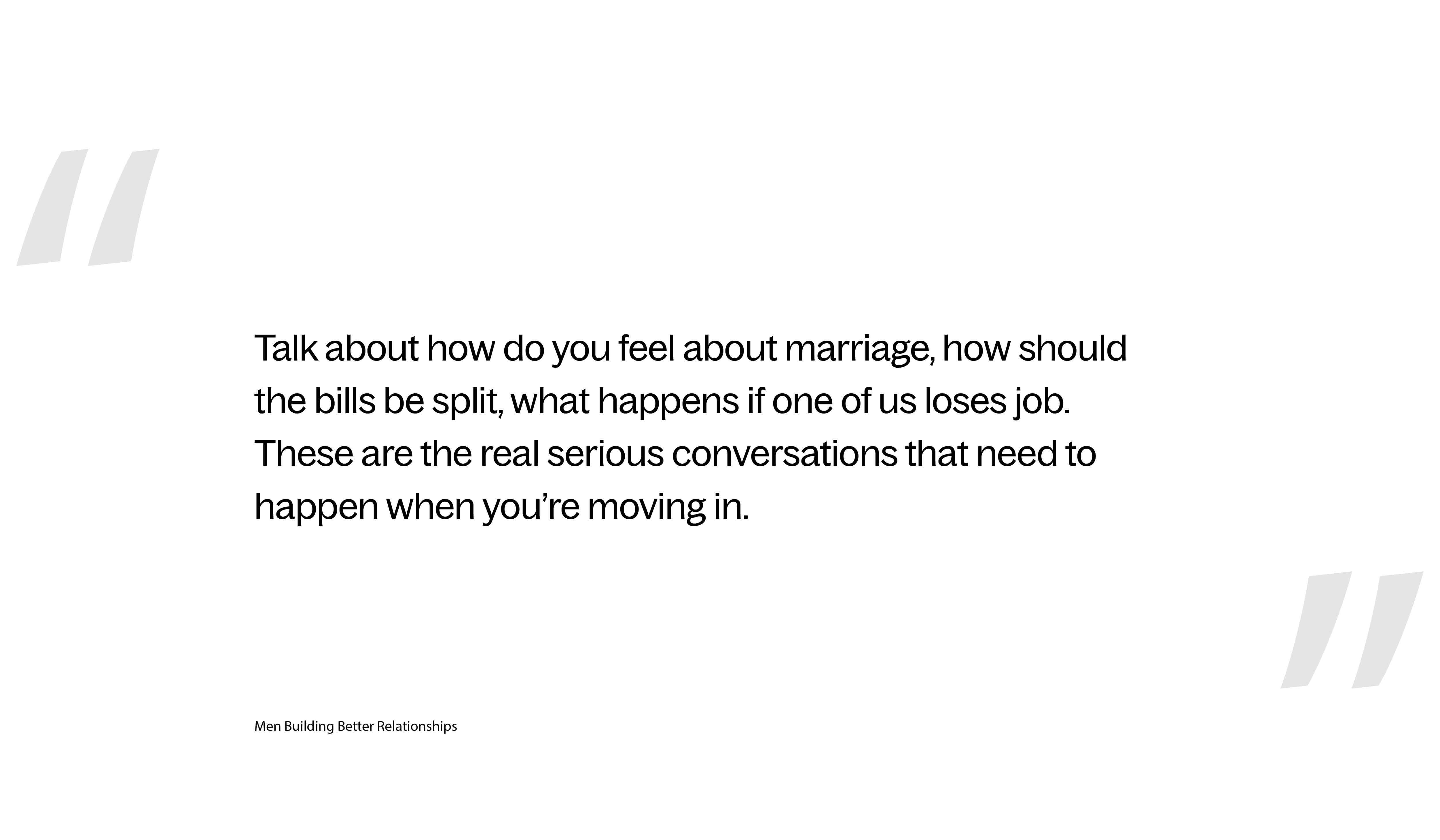
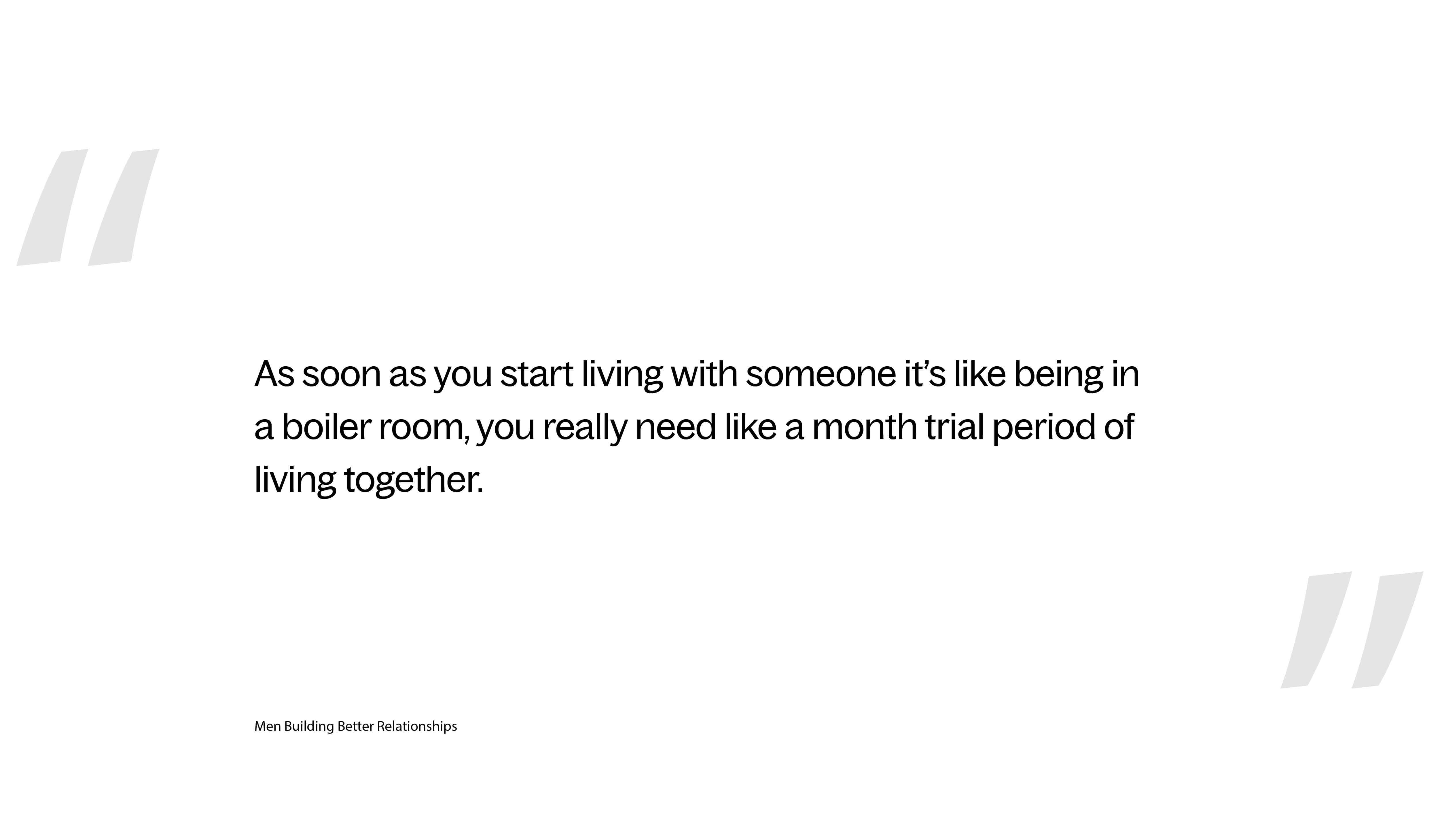
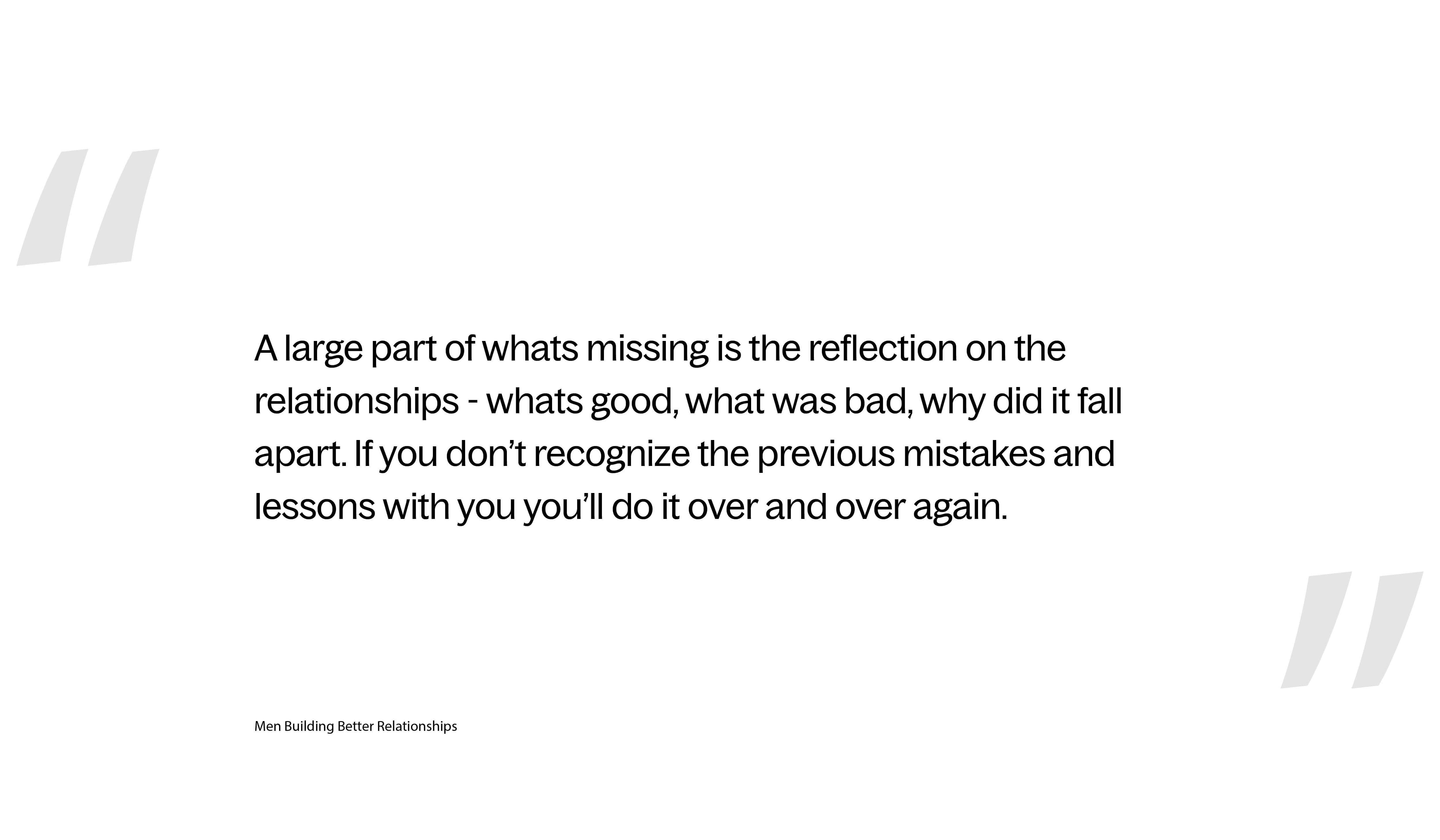

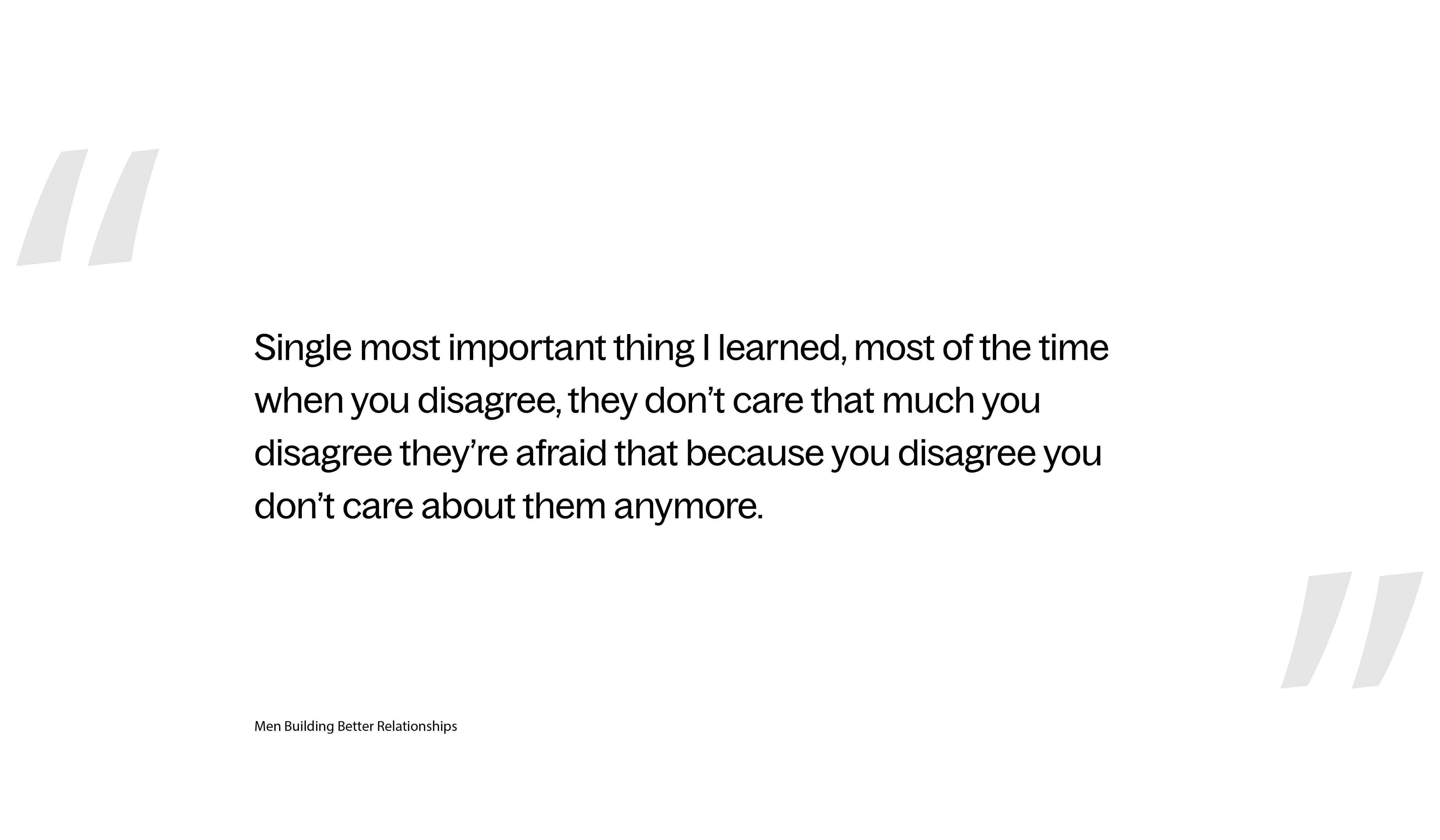
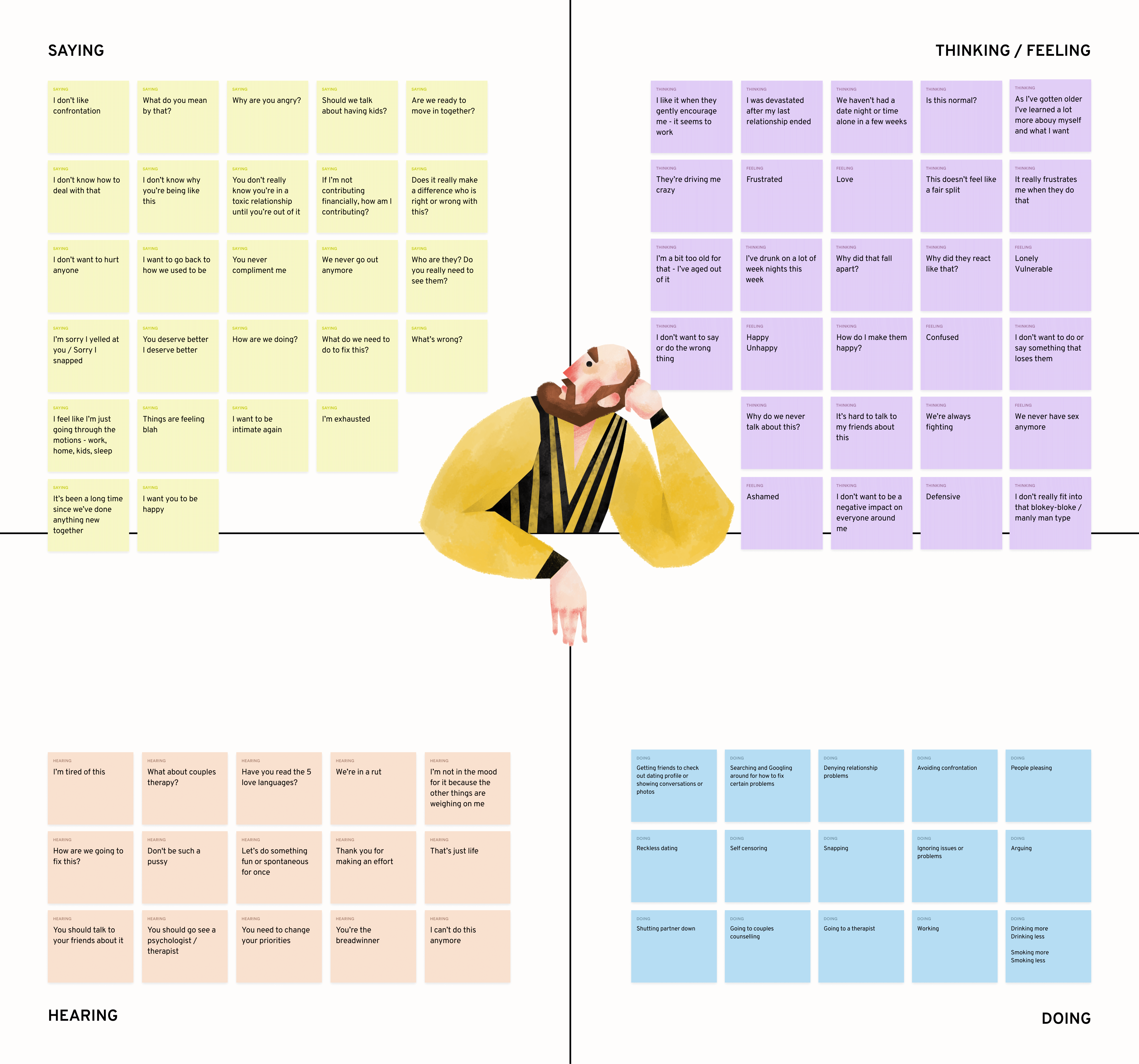

Deciding to focus on younger or older men
The academic research had mostly covered men in their 30s and 40s, however, there had been discussions of moving downstream to focus on younger men. Through our product research, I could identify a surprisingly clear age in which relationship thinking and patterns appear to transition. My research also consistently highlighted that young men wanted (and perhaps needed) to experience "starter" relationships.
There were key areas where young men had significantly different content needs, from men who had relationship experience.
There is also a growing divide between young men and women on their views toward relationships, sex, and each other, increasingly influenced by the online world, requiring strong guidelines as an organization. I pulled all this together alongside content pathways we would need to take and which channels would need developing. After digesting this, Movember chose the 26–44 age group (largely millennials), before potentially moving to the younger stream beyond this as the strategy on this developed.
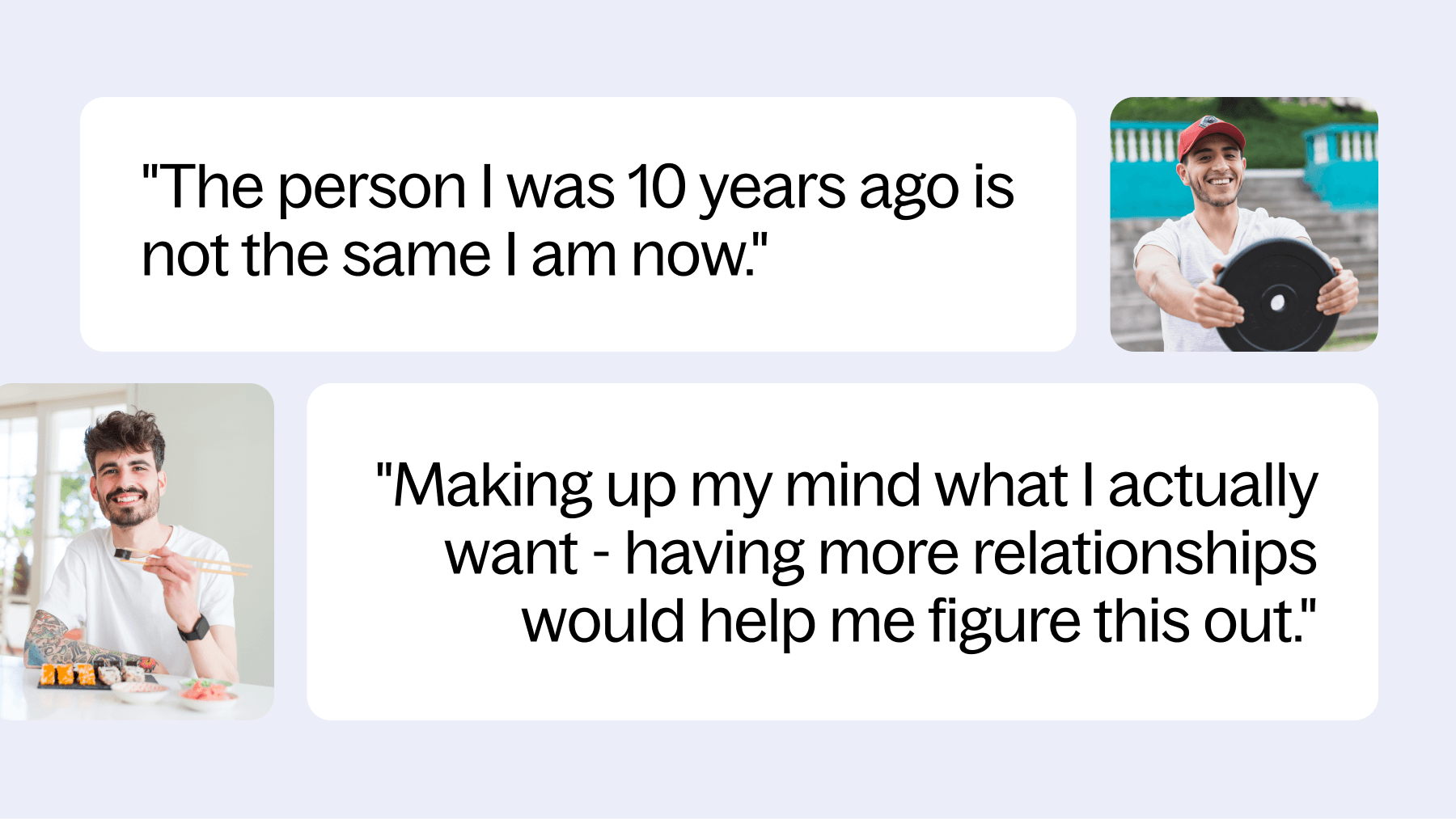

Building a product by stepping up a staircase of needs
From the research into men's needs, we knew we needed to start by engaging men and supporting immediate needs before progressing into more complex areas. From expert insights into high drop-out rates of men's therapy attendance, we also knew we needed to be able to provide quick value, action, and establish trust. With this in mind, I created our first take of the product staircase to illustrate how this might look and ensure that all of us understood the journey we were building for (that might change as we learned more en route). I created this to be product-agnostic and built for impact. We knew the behaviors we wanted to change and the intended positive outcomes for men (and society), so at each step we could meet this with the right campaigns and tools rather than be trapped into one solution. This also laid the foundation for our product ideas and content — what do we need to do now, rather than building for an unknown end product?
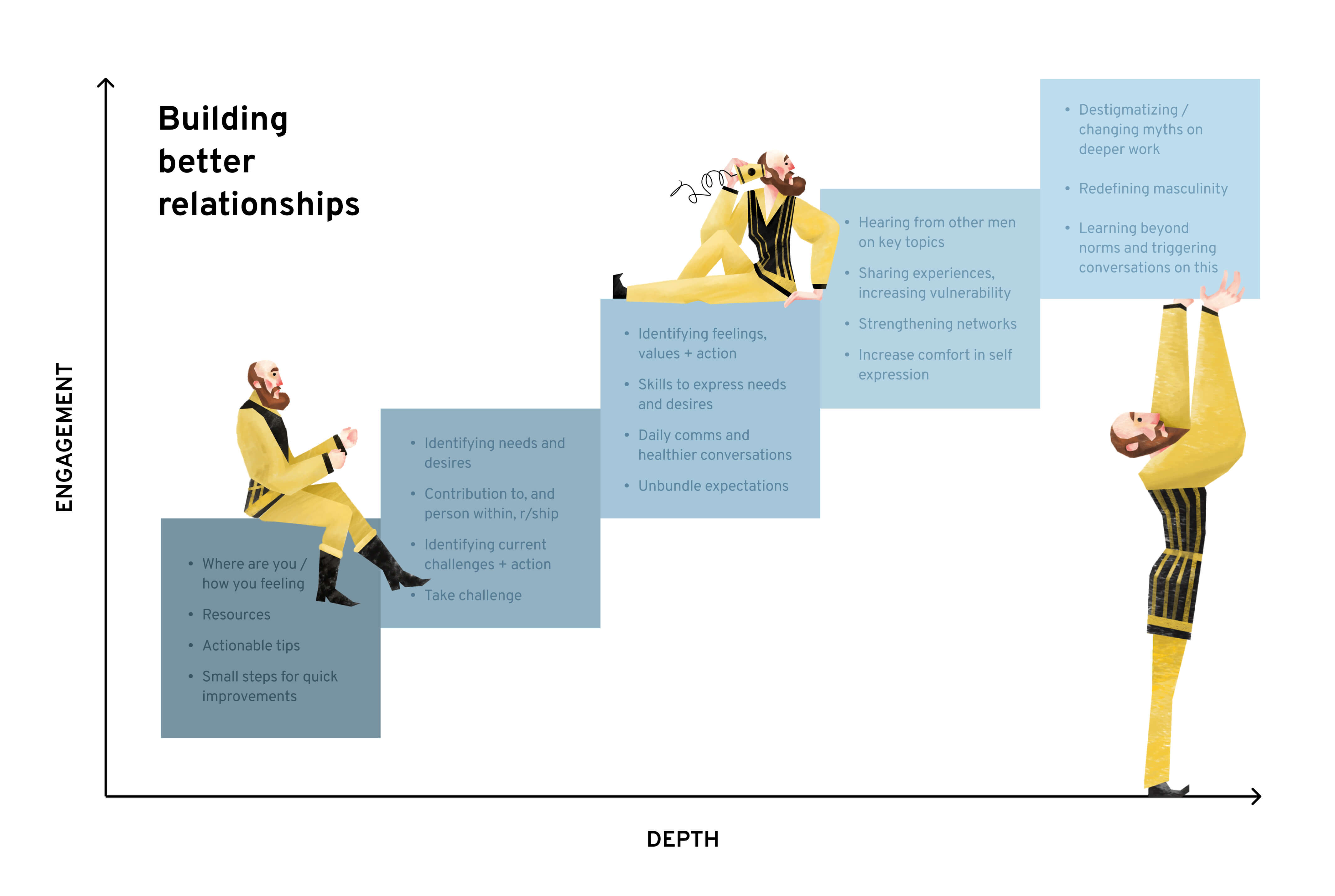
Bringing in insights from ecosystem research
Finally, to ensure we were also meeting a market need and clearly understood our positioning and value, I undertook a large sweep of the market, other organizations and charities, our research papers, studied numerous other papers in the field, and compiled supporting evidence whilst collating our unknowns and what was missing. Academia, community services, government policy, legal remedies and private products are mostly focused on addressing downstream issues, including intimate partner violence. We wanted to head upstream to skill building and encompassing all men in their efforts to create meaningful, healthy, fulfilling relationships. This is generally where paid, private programs existed, but where corporate and government interest was growing. There are some awesome men in the private space doing great work. In reality, only a very small group of men are likely to take up paid courses so our project was aimed beyond this, but the information some of these men regularly provide in social videos can be really useful and if found and the person is relatable, can provide engagement on the topic.

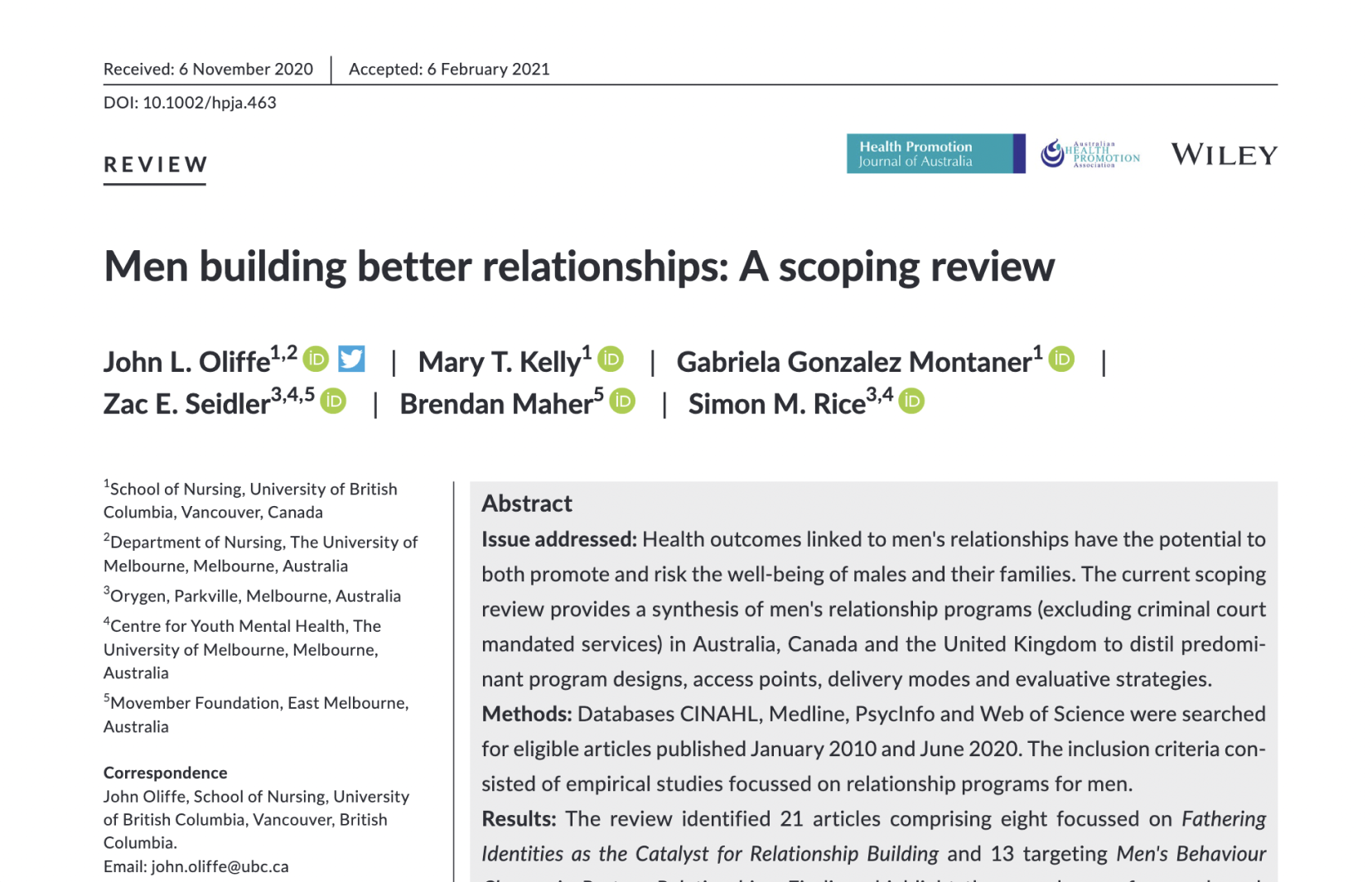
Developing non-shitty personas
With that in mind, instead of creating detailed demographic personas, which are generally not useful, I developed profiles of people that arose during research and would be useful to the product direction, content development and marketing. Interwoven through these were hundreds of personas and combinations that existed within our target audience, all with different personalities, experiences and relationship scenarios.
I wanted to move away from overly complicated segmentation (a more rigorous accurate-fit-always approach) with pragmatic market segmentation (capturing 70% of cases) in order to make it practical to use and provide us enough confidence to act. I also stripped the typical ages, faux names and photographs from these profiles. We gave the profiles colors, neutral gender constructs, locations and cultural backgrounds within relationships. Though each of these would require specific research, content and marketing, the broad themes remain similar.
Try yourself: List what would actually be helpful to know to grasp the person you're targeting. What gets everyone across the business aligned on the audience and figuring out how you're attracting and helping them? Any big gaps that you feel like you should know? Don't worry about most demographic data unless its pertinent to what you're doing.
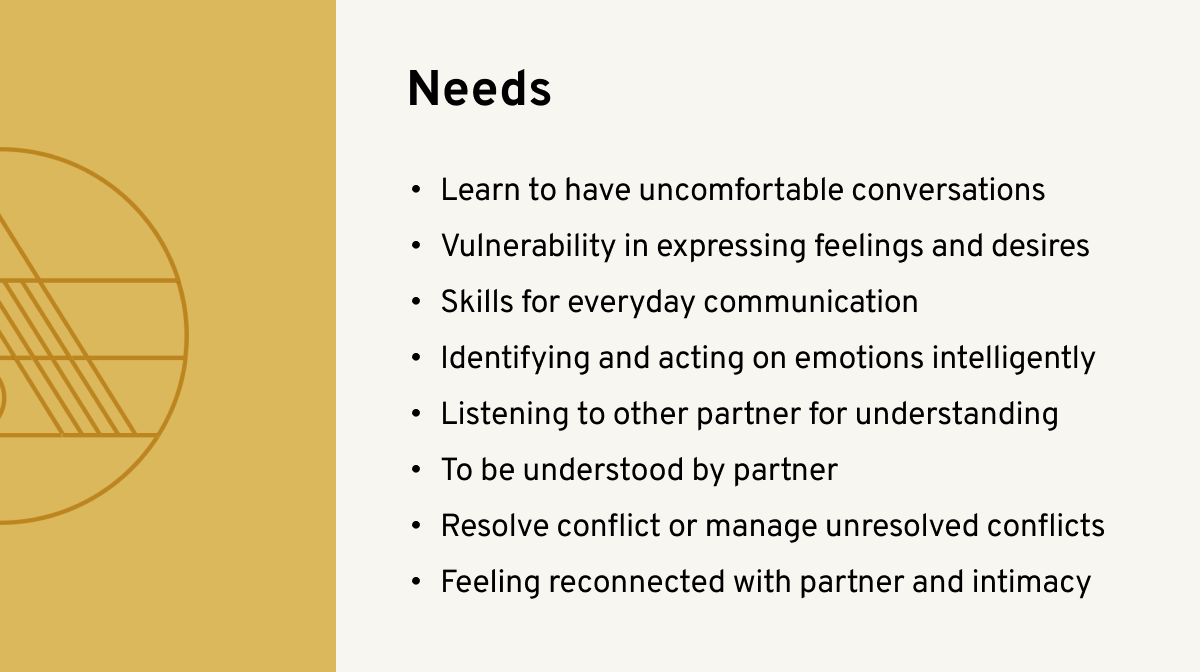
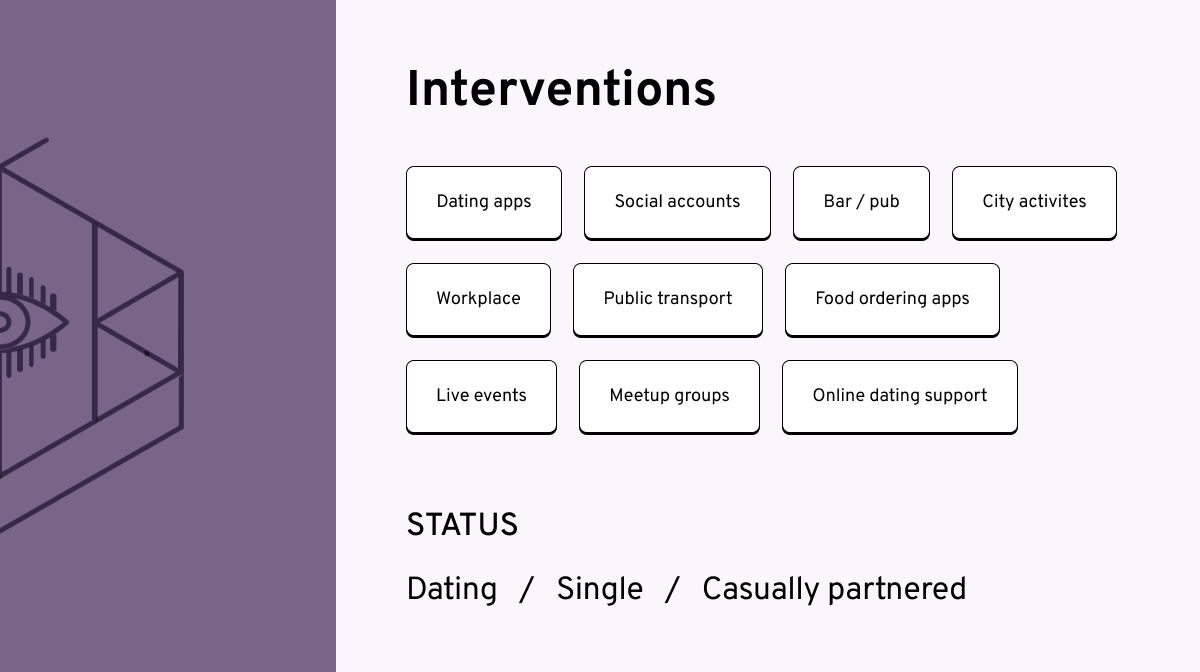

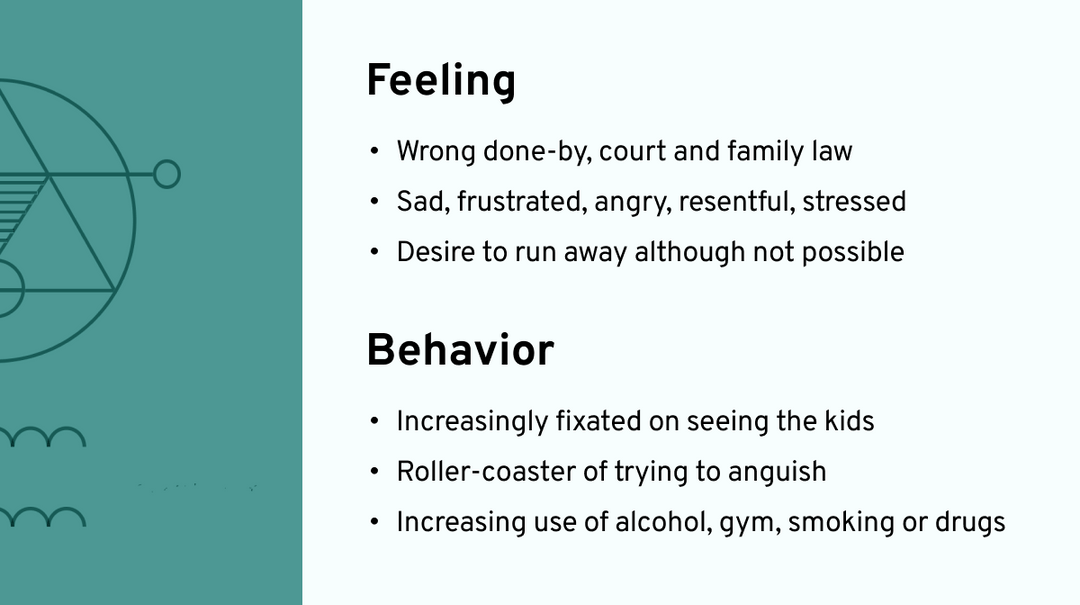
What does a good example look like?
While a lot of the world is focused on a specific brand of masculinity and there are prevalent examples of poor behavior everywhere, we rarely highlight good examples, including healthy masculinity. I explicitly asked for role models (from growing up through to society) during research and had picked up on a few specific trends. Humans tend to need positive imaginations (much like what falls out of research in the environmental movements). This is tricky though as pinning people to that role can be highly risky. What we did need though was to consider what healthy actually looks like today. We also needed to rally everyone internally around what "good" looked like so we had a framework of intentions and an idea of a healthy relationship that felt fair, meaningful, and realistic for all partners involved. I found clips, examples of writings, speeches, books, and podcasts that we could talk about. I mapped the insights from studies and interviews I conducted to create a pattern of healthy habits and referenced these with the academic research. We developed a long list of known men that exuded different elements of positive traits at different times (there are many!) and cross-checked these with our target audience. This broader approach provides different results than you can have when workshopping directly with men which is also interesting and there is excellent information in the gaps and additions when doing so.

Developing a comprehensive product strategy
Being a product with such a potentially significant impact, needing to translate academic insights into real-world applicability, and requiring a very clear direction in order for the organization to proceed, I developed a comprehensive product strategy that covered our direction, triggers, the hook model, feasibility, desirability, individual and population impacts, unintended consequences and what we should consider, where further research was needed, and how we would carry this all out. A question I was consistently asking myself : how do we best measure the meaningfulness and health of a relationship in a way that is just (because the happiness of one may not result in thriving for another)? The strategy was approved and onward we went!
Expert review
I just read through the product strategy and am utterly impressed by how awesome it is. I feel like you should publish this document, as there are valuable insights and lessons to be gleaned from your extraordinarily thoughtful and thorough consideration of the issues, perspectives, and potential populations involved. I also love how the organization and flow of your comprehensive narrative reveal that you have anticipated questions, and how your compelling responses to those questions confirm the necessity and enhance the appeal of this product.
Judy Chu - Ed.D, Author
Chair, Movember Global Men's Health Advisory and Lecturer at Standford University
Partnership for Male Youth Board of Directors
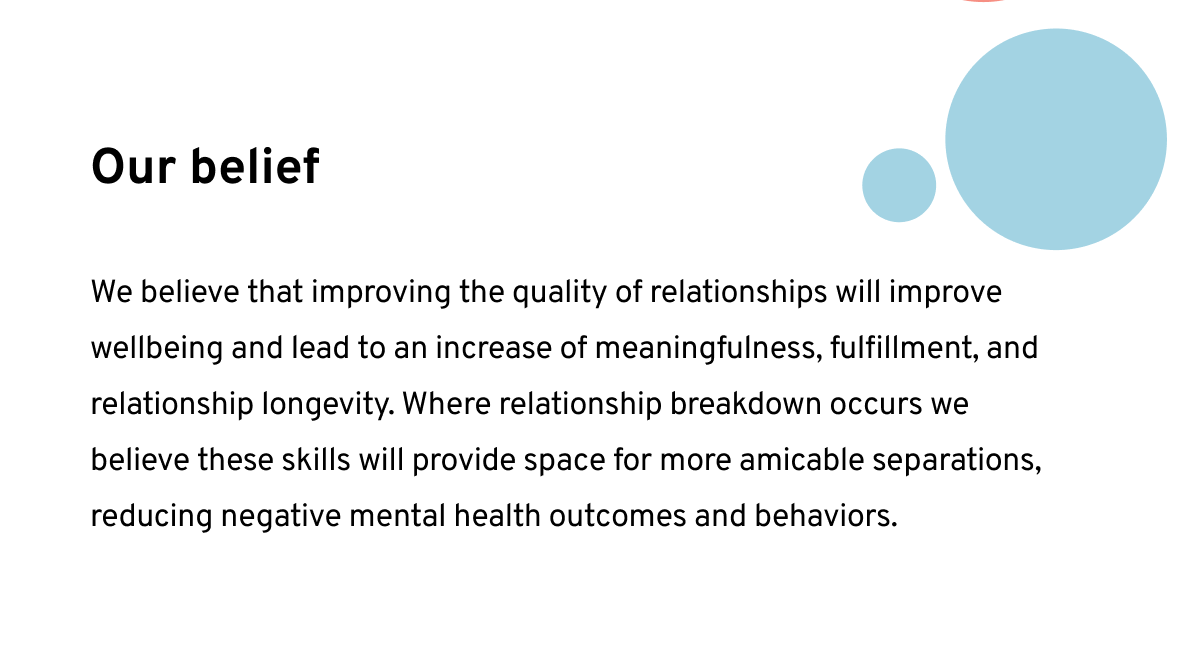
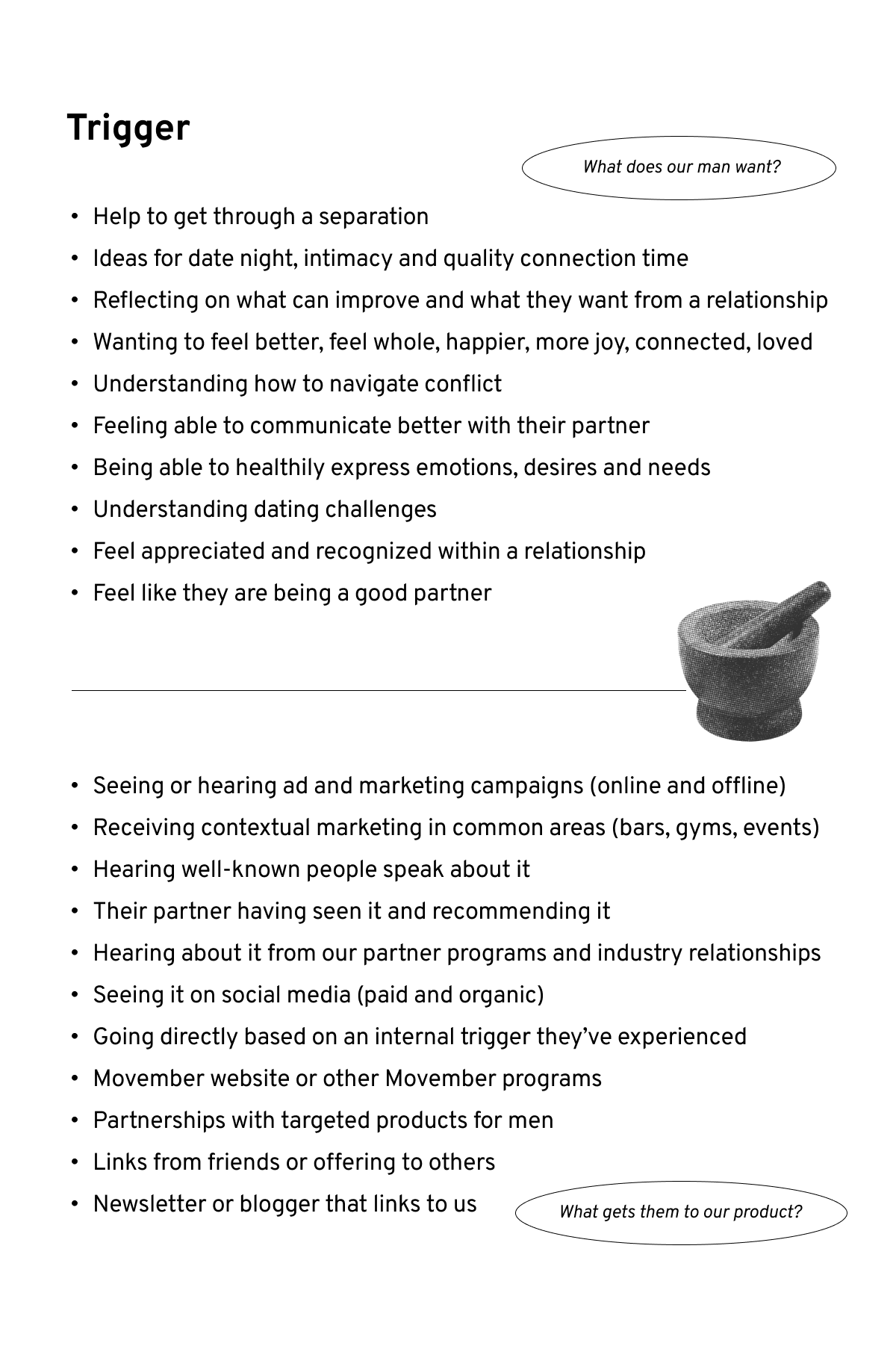



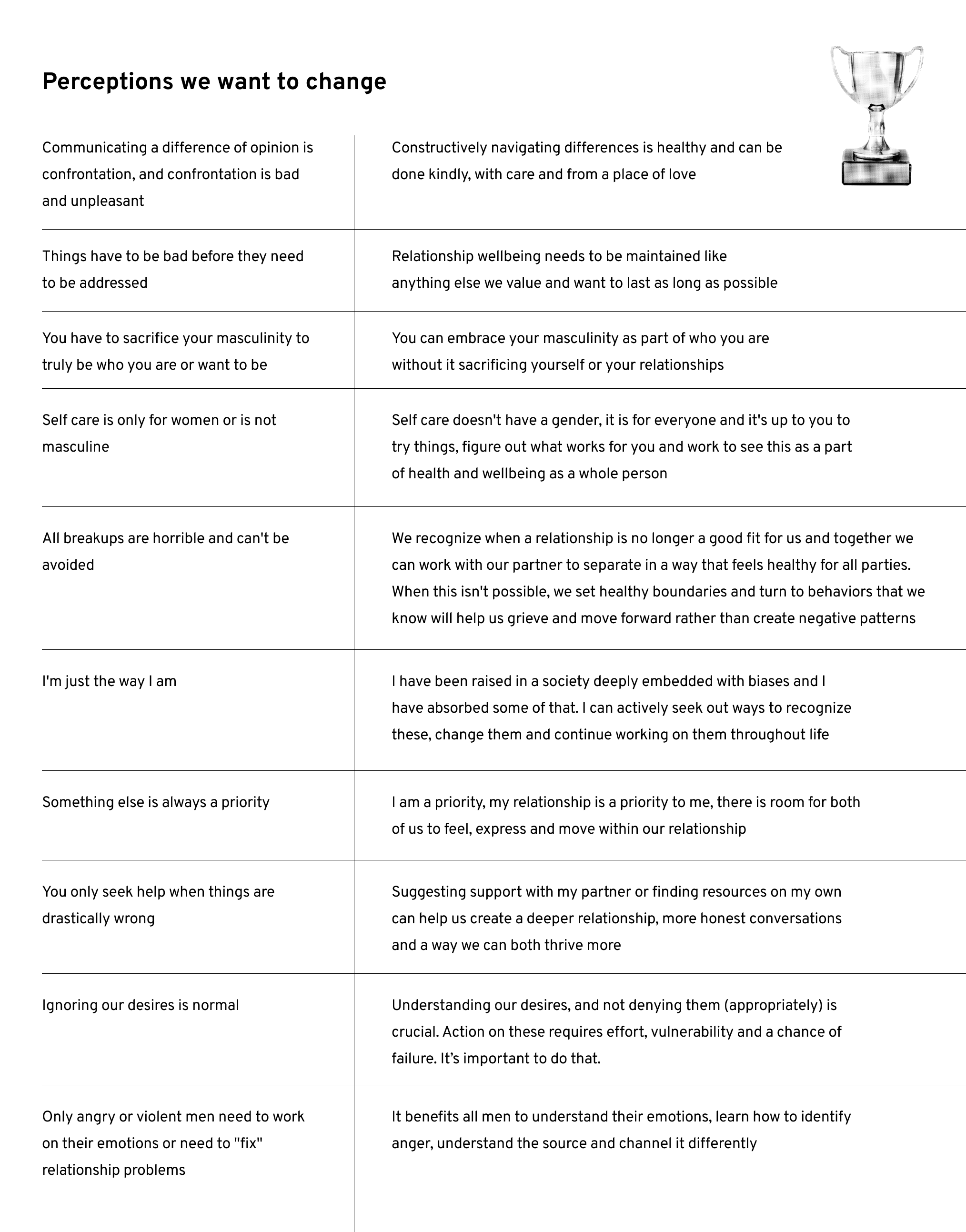

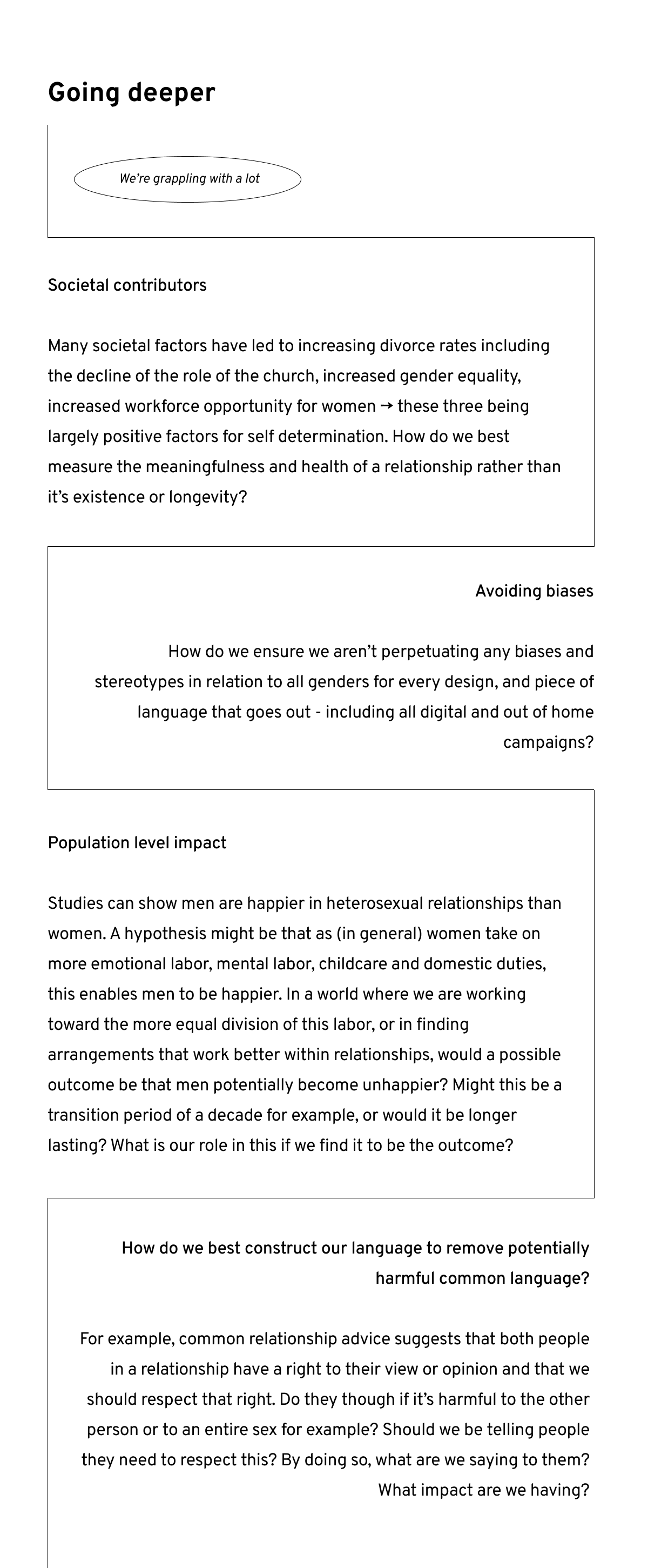
Creating our levers for intervention
I outlined our intervention points to understand where our men are and how we can leverage the patterns at that moment in time to drive an action forward. I developed these using the theoretical model of change. Although decades old, this model is used a lot in health interventions and was helpful in knowing what our triggers are, what our audience might be thinking and doing in each phase of the change, and what our target men might need to push them forward or maintain.
These were also designed to be used during product reviews to aid in identifying the stages of intervention and whether these have held up or require experiments or adjusting. Continued future user research should also review these and ensure they are still accurate or updated as appropriate. I highlighted attitudinal and structural barriers and spoke about these with our experts for ways to work with them or remove them.
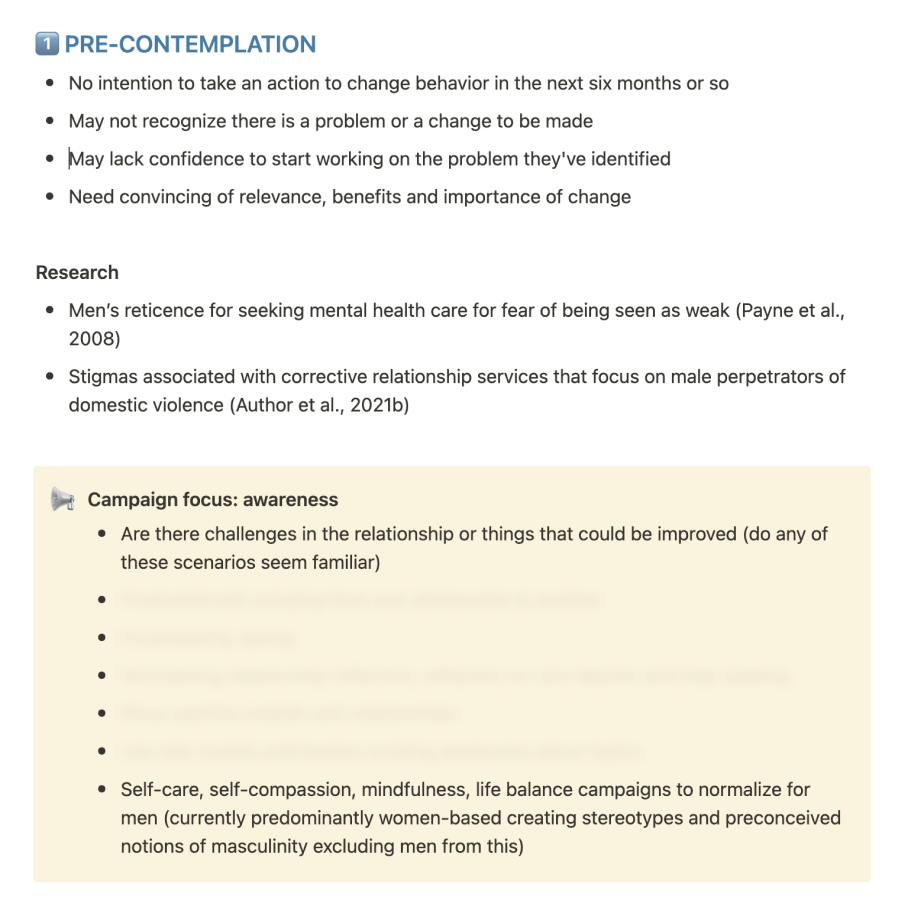
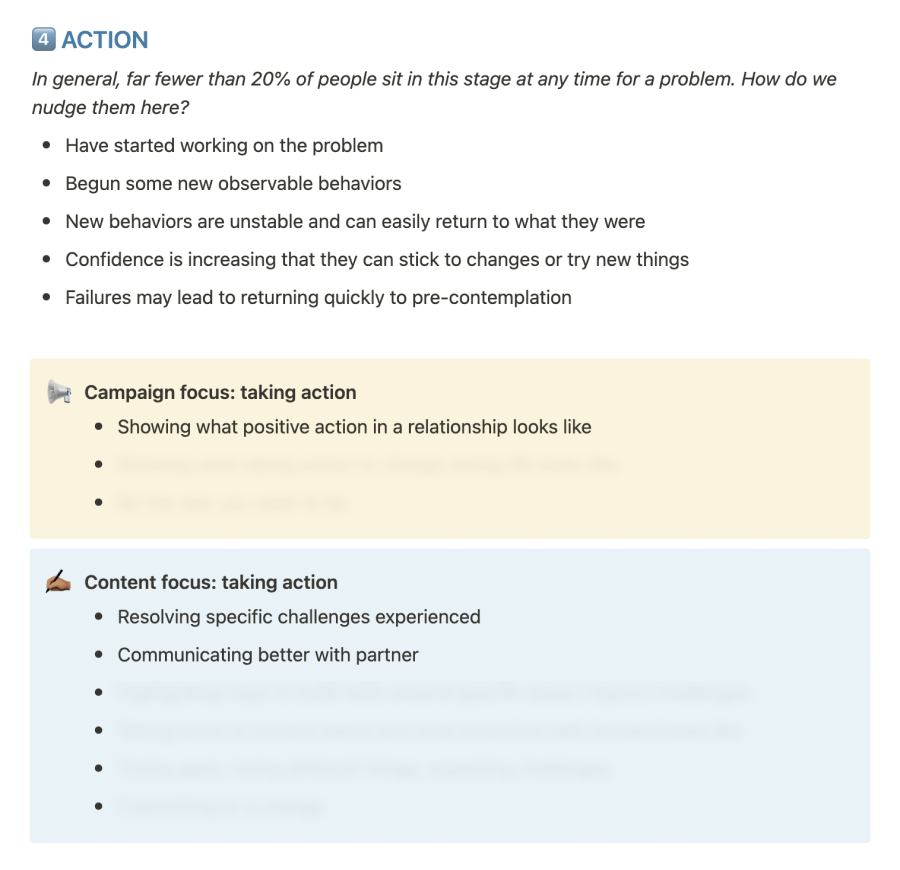

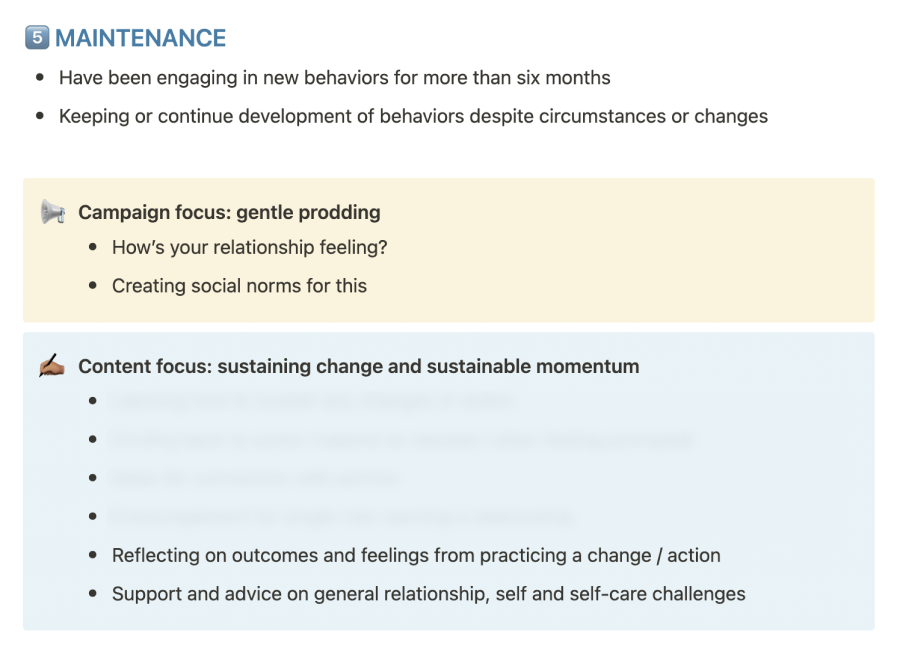
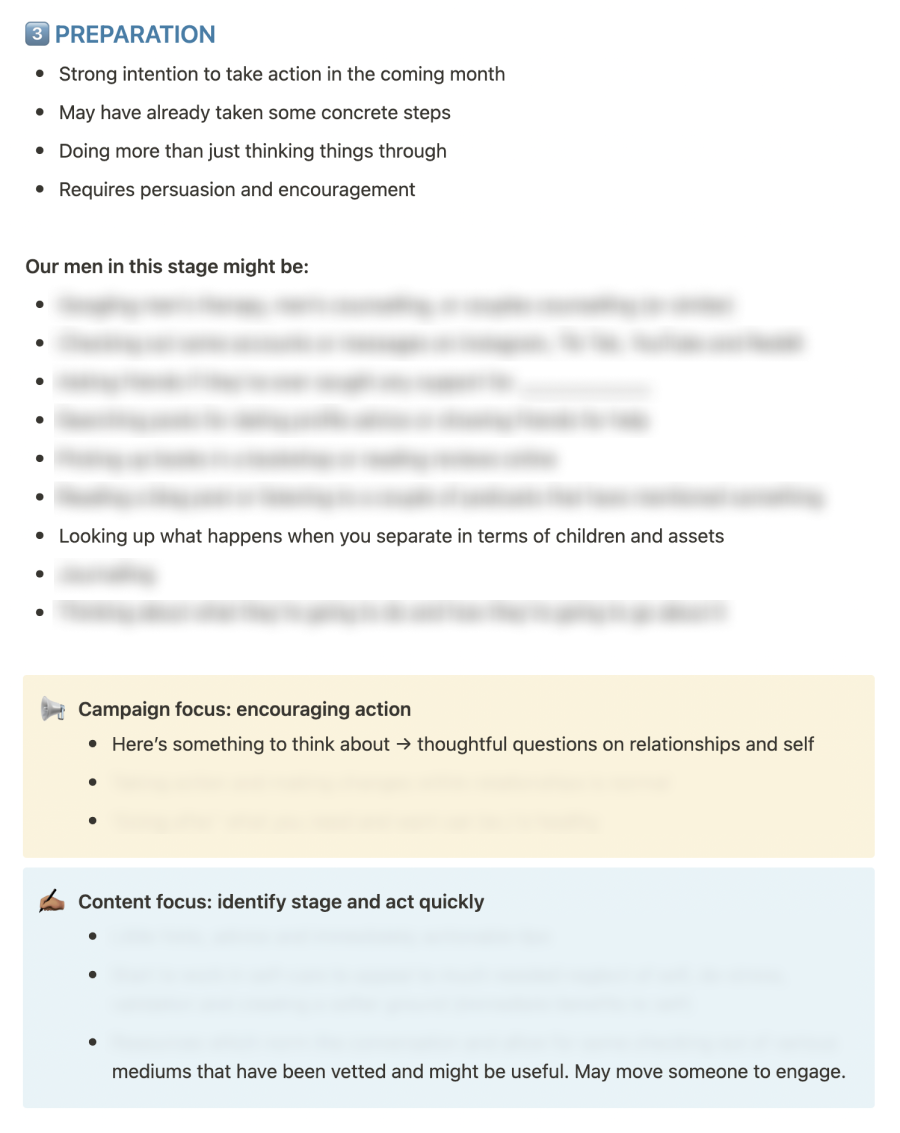
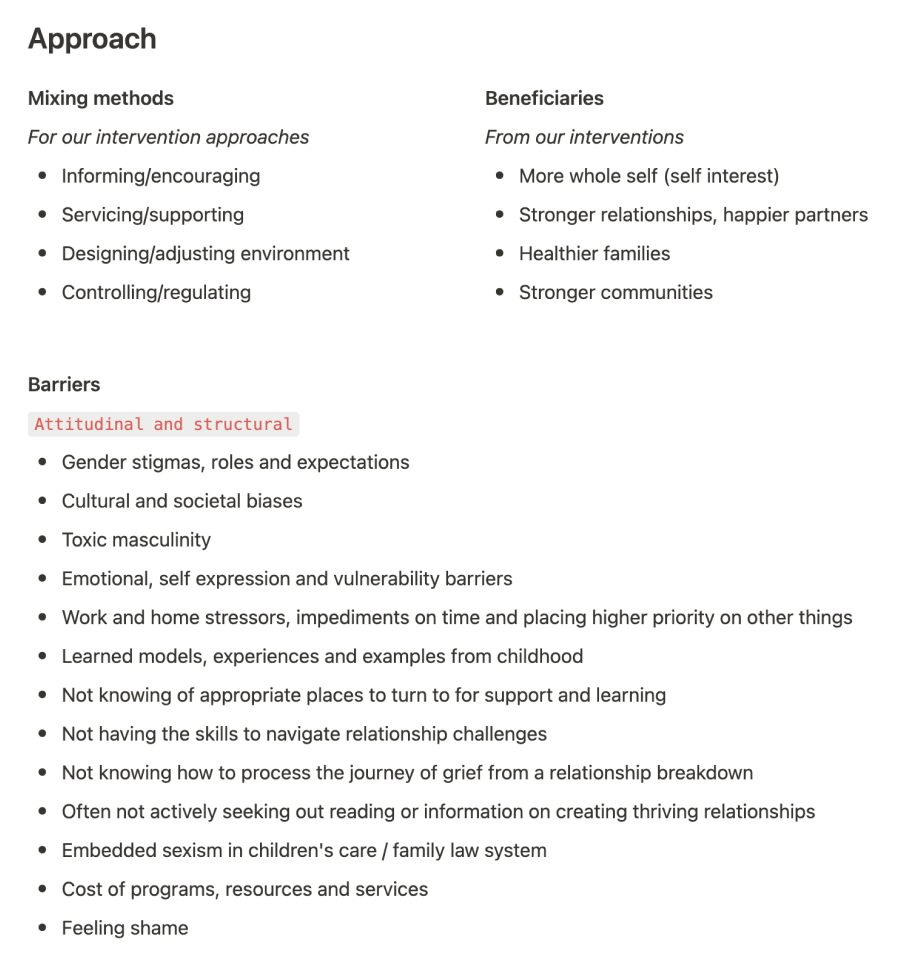
Shaping the product
With the initial research phases over, I created and facilitated an ideation workshop to go as broad as we could with ideas. We included experts, target audience men, Movember team members, and the CEO. We had a lot of fun and also produced a whole range of ideas to test. I brought together these themes and pulled the highest-ranked ideas into a testing plan. After testing the ideas with a new round of research participants, I analyzed the results, pulled out the trends, noted what required changing and which were most likely to engage men and be useful, and presented this for executive consumption.


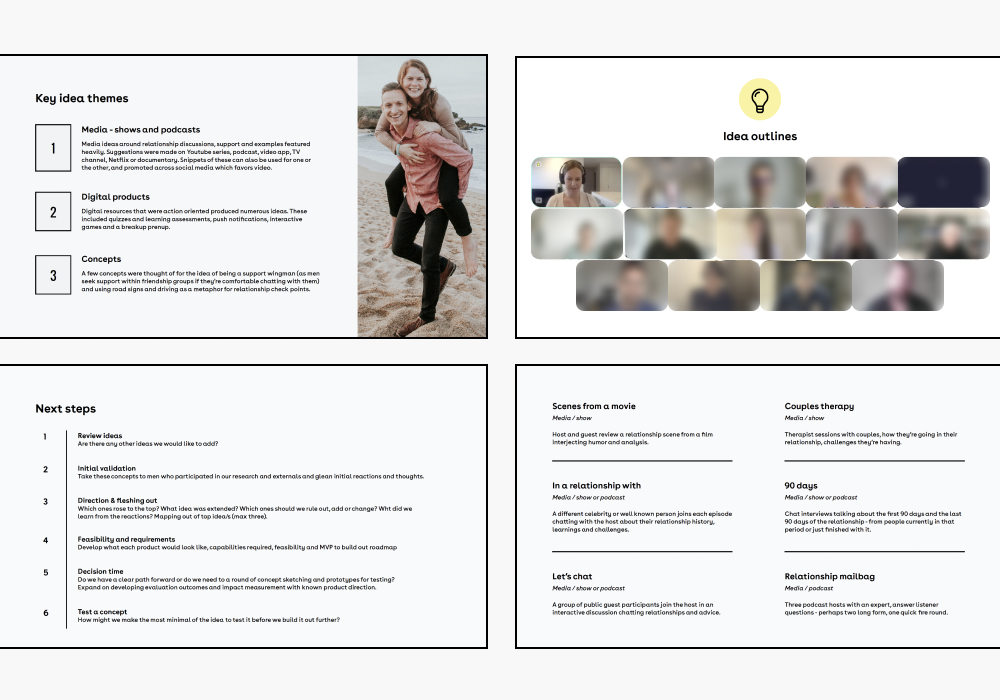
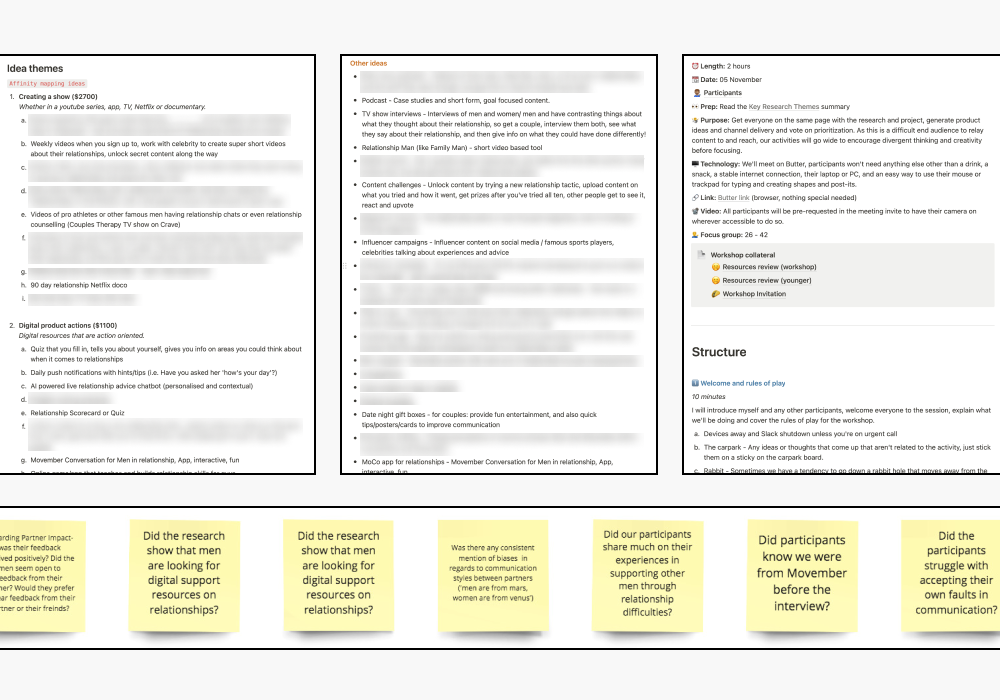

Research participant
Where this is going is really great - it’s a f*cking great start. You’re more than on the right direction, you’re where no one else is which is miles ahead.
A glimpse of what I'm grappling with
- Can we attract men to this? What's our best entry in? Once they're in, are they engaged?
- Many men in the research wanted more amicable separations but didn't believe this was possible
- How can we best learn from what so many men are doing well in - and enjoying - healthy relationships and apply this to others that may be facing challenges?
- What can we do to focus on some of the smaller moments, paying attention to each other, while so much of life is consumed by systemic issues?
- Some men are in terrible relationships that they cannot "improve their way out of". How do we help men identify where there is room for self improvement, and those who need help in determining how much effort and how far they should go?
- Breakups and divorce are often empowering - at least for one person, and they can often be the right thing to do. Measuring decreasing separation is likely the wrong way to measure success.
- Measuring satisfaction or wellbeing may be difficult - if you separate and it was the right thing for you, you may still experience many months of pain and decreased short to medium term satisfaction with an increase for the medium to longer term.
- Are the relationship difficulties for those with children, and those without so much greater we need different content streams?
- If it is women who are initiating separation more (for the right reasons for them), men are more likely to face negative mental health outcomes (as studies indicated). How do we instead build resilience in this scenario so that people can still make healthy decisions for themselves?
- How would we notice this impact? For example, increased friendship time, increased use of therapy, decreased suicidal ideation?
- How do we measure the amicability of the new structure beyond a separation which might give more insight into its health?
- If we are able to create a healthier relationship that subsequently avoids a separation that might have otherwise taken place, how can we measure this?
- Many heterosexual men in studies and interviews mention divorce being a surprise to them though it was likely was thought through a long time by their partner. What are some signs or calls for connection or help being missed?
- Men were experiencing relationship challenges but weren't actively seeking resources, help, or support. If you're a man reading this, what would compel you? Where would you go? Who are you most interested in learning from?
I have significant deeper insights and ideas. I'd love to chat about this if you're working in this space.
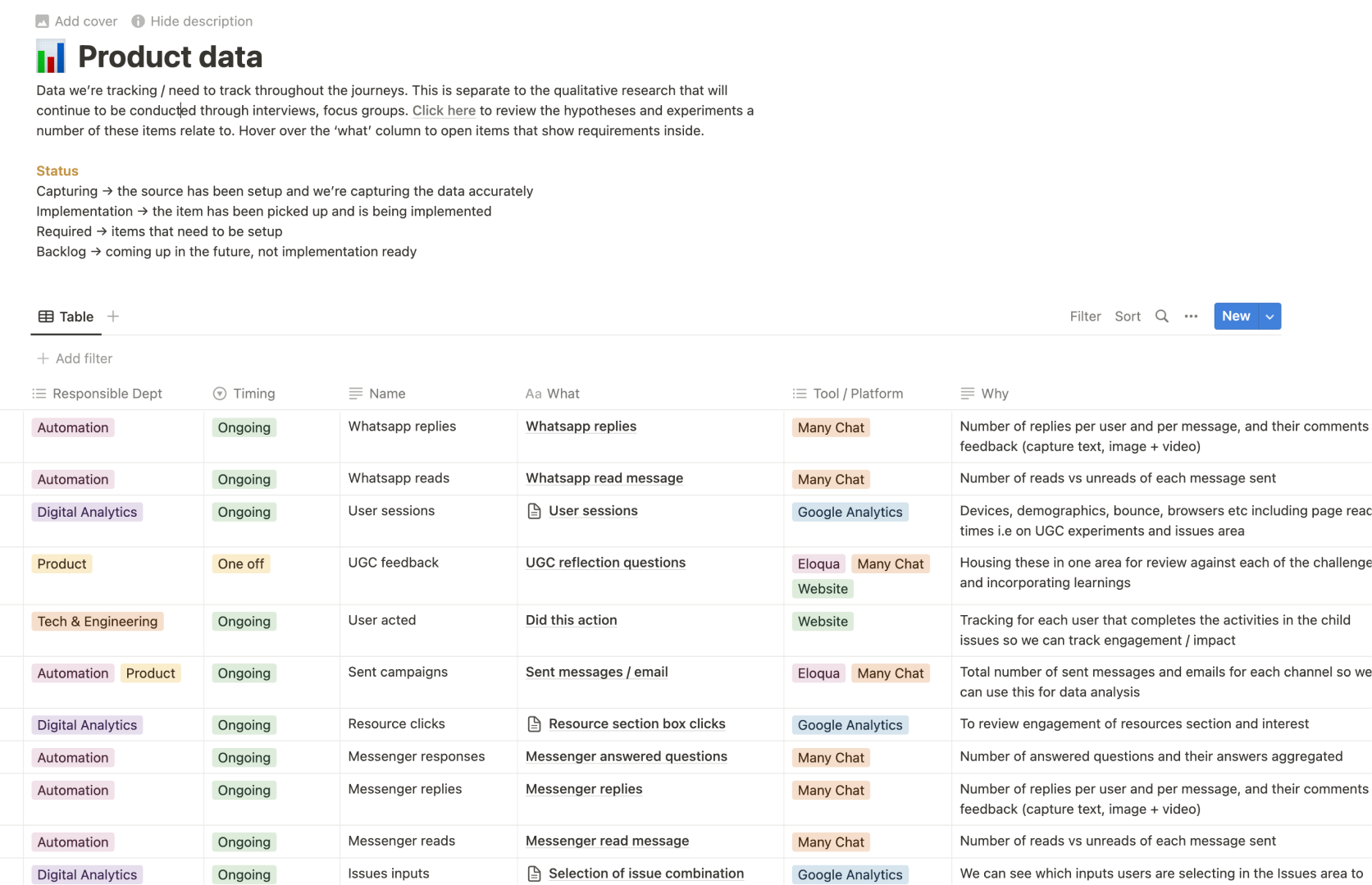
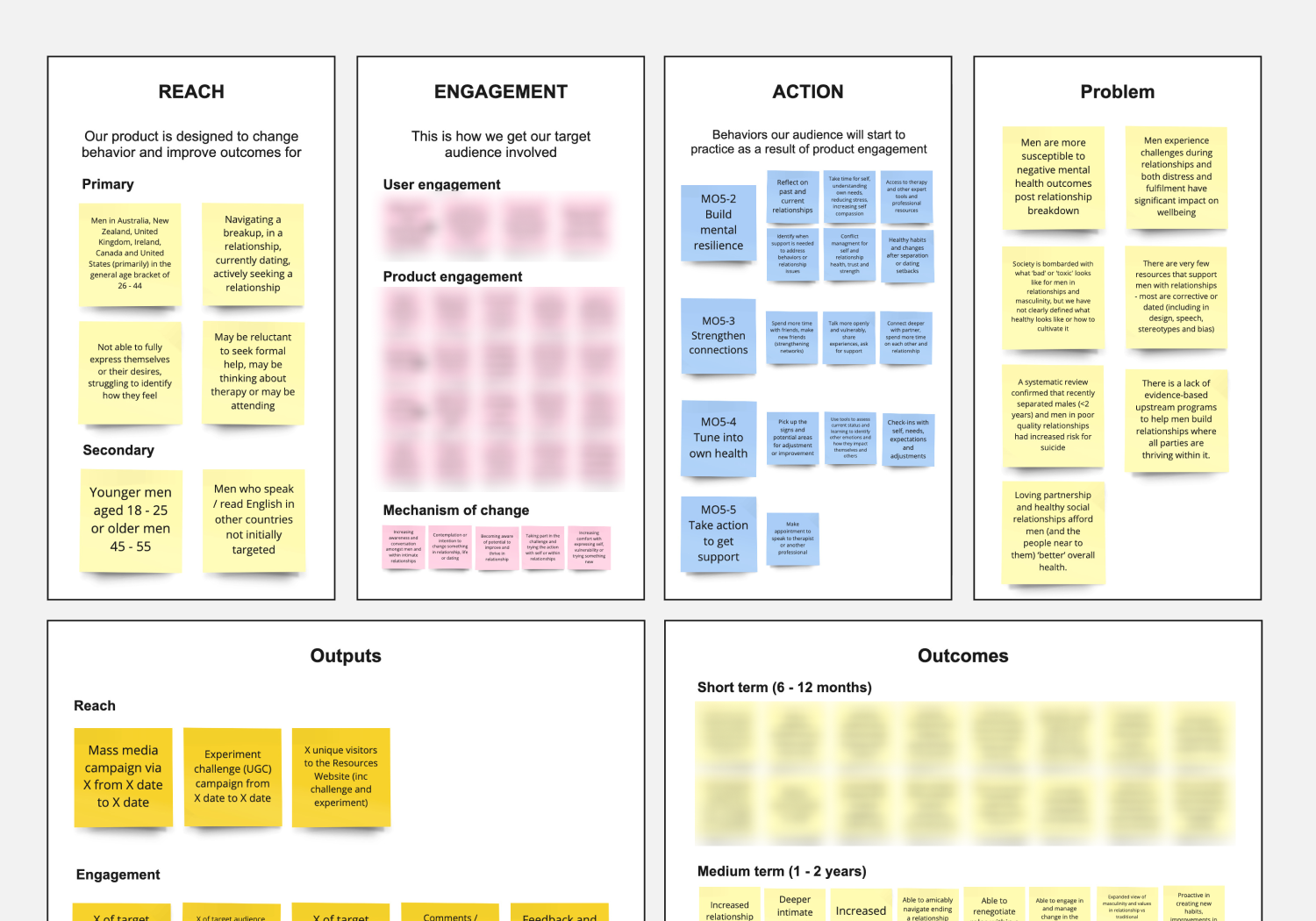
Planning for product and population impact
As the product developed, I mapped out the theory of change and Movember's internal impact planning map. With the product content going through a randomized controlled trial (RCT), we were also looking at more comprehensive evaluation to help guide the product in the world. After the initial product release, and with some more insights, I crafted a clearer roadmap of how we might consider impact from six target levels and the measurement methodologies we needed to put in place to grasp our impacts and demonstrate them. In thinking about our impact, I grappled with numerous complex issues and spent time talking through these with our advisory committee, the wonderful impact team, and managers.

Developing useful content and channels
Producing the content we needed to start with on our staircase involved a significant amount of time. I needed to translate what academic approaches outlined, what men wanted and needed, how we could package this up in a digestible manner, and which channels we could leverage. We also agreed we would expand this into amicable separation as a lot of problems were manifesting here, and an increase in amicable separations would be healthy. Lastly, in order to test how men best consumed and interacted with content I turned it into various test types that covered academic suggestions, research insights, and what we know from what's working already:
- Ten different methods of delivery and interaction on the site
- Short form Facebook Messenger content
- WhatsApp content with followup polls for instant feedback and additional responses
- Longer form email content converted from the messages
- Social channel content
- Campaign test ideas for publicly consumed content
By far the most challenging to work on was the tone of content and its inclusiveness. As a relationship product for a wide audience, we gleaned how we needed to sound through our research. Additionally, this field is flooded with certain influencers and figures with a strong pull; the way they speak and their tone often engages men. I pulled together numerous examples we could share amongst the experts, product, brand, and content teams to dissect what parts we liked, what we didn't, and how we wanted to sound.
From here I established our guidelines for tone and, alongside the Product Director, a process we could use for developing the content from expert input (particularly important in developing activities and topics) through to the final output. One of our experts, a men's psychologist, then read through our pieces and edited them to provide clear samples of the tone he wanted to ensure was used throughout. Ultimately, I worked with our experts to create core pieces from our hypotheses, including a user-generated experiment of activities, remedies for common problems with instant action steps, activities to participate in, a video series we could evaluate, and a limited weekly challenge through instant message channels.
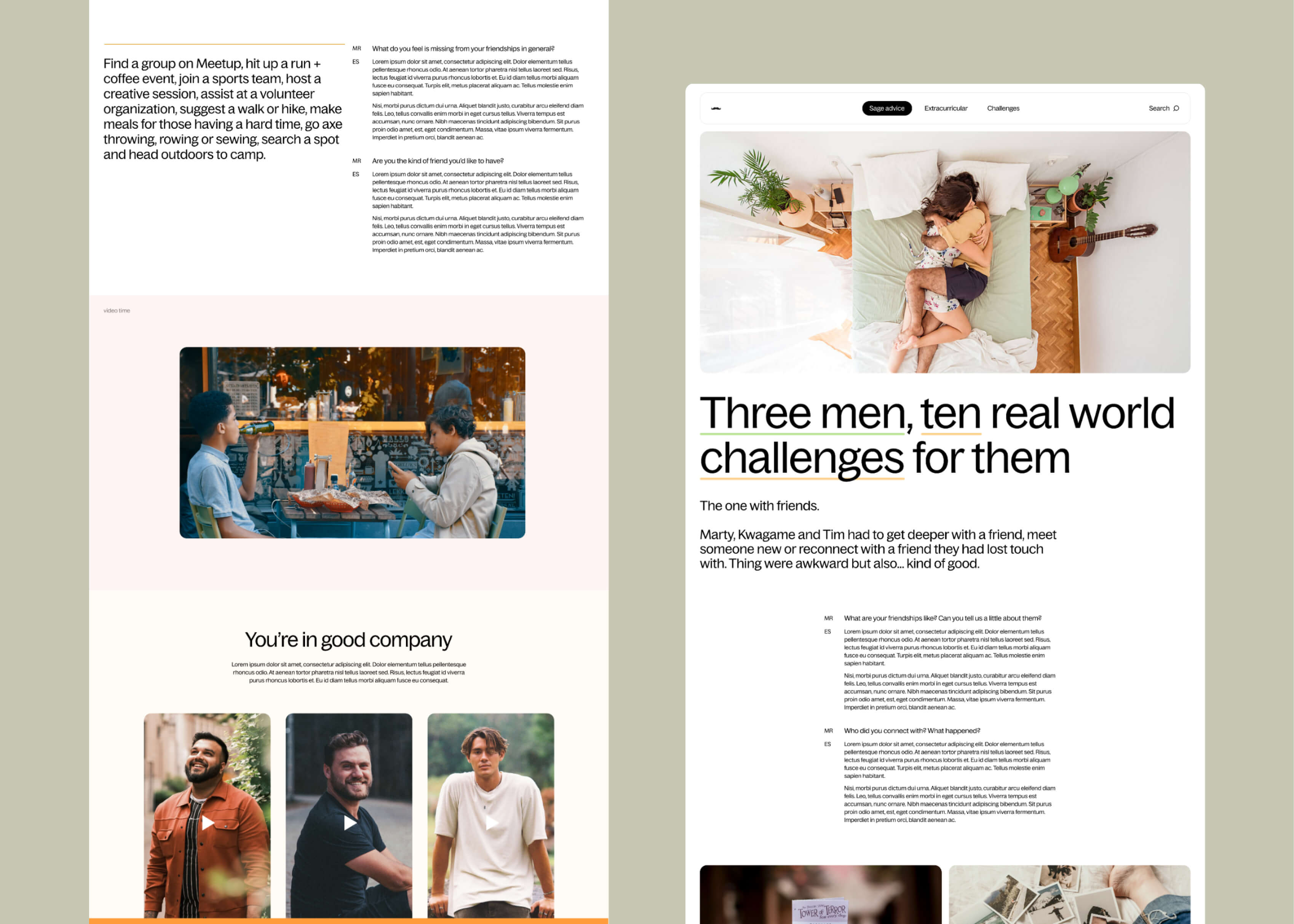

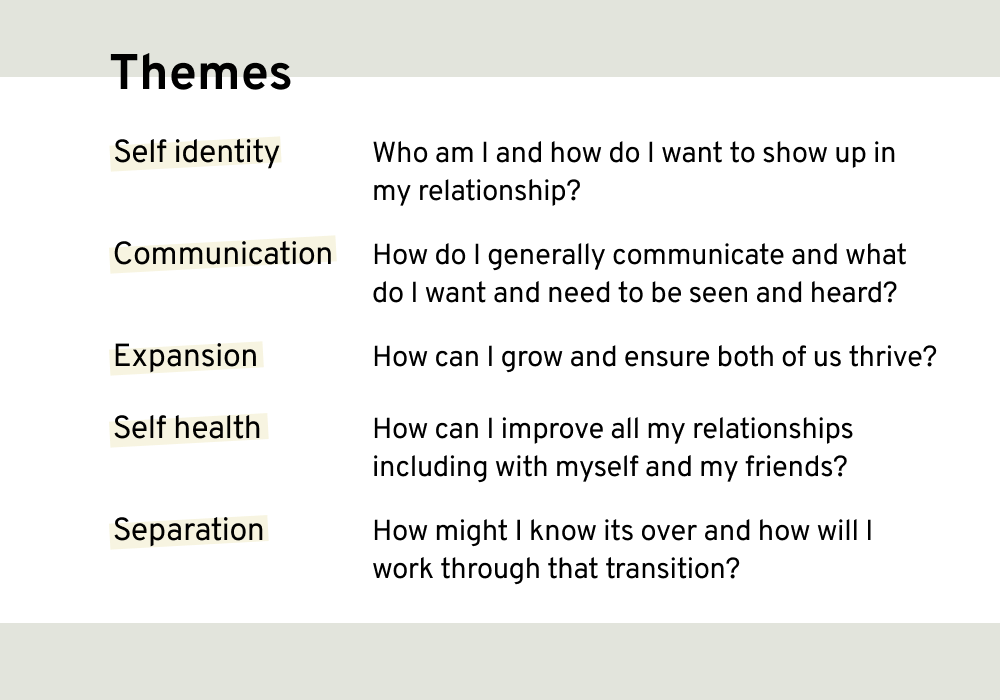
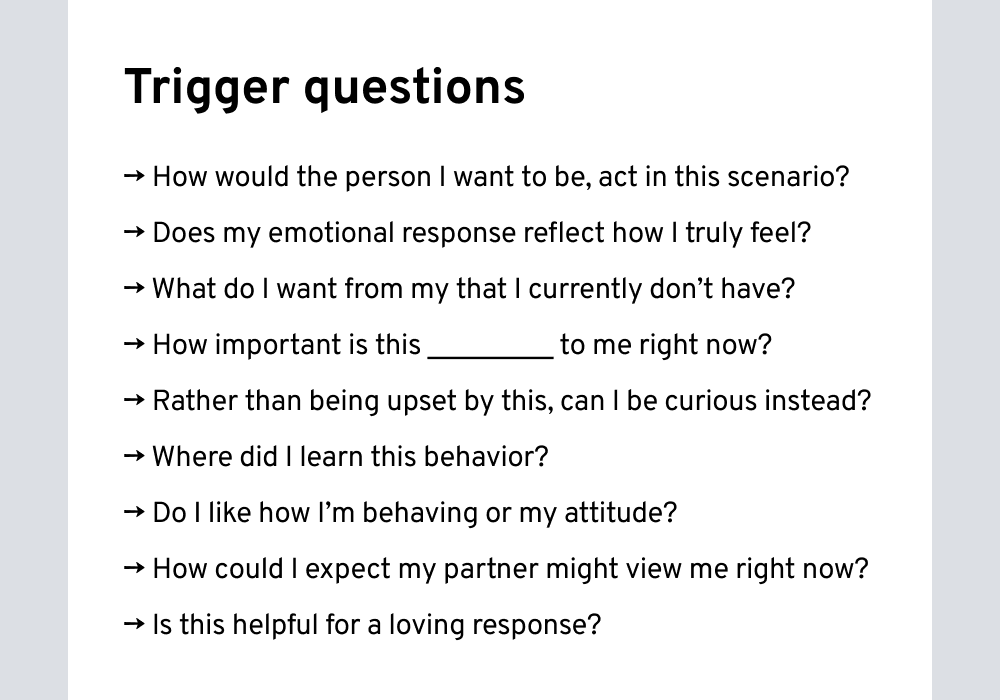


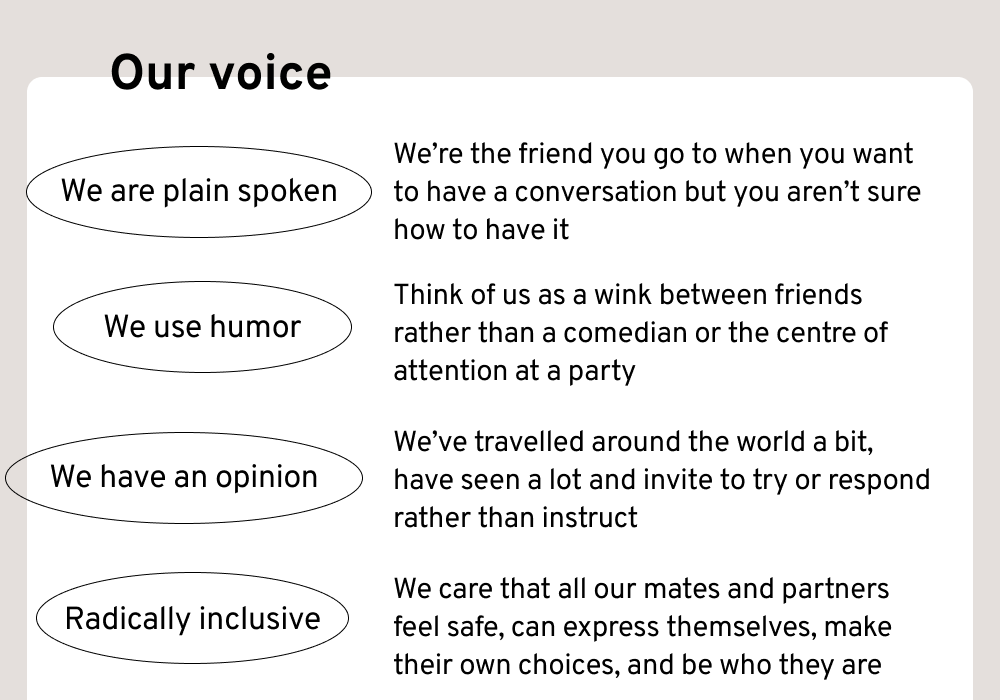
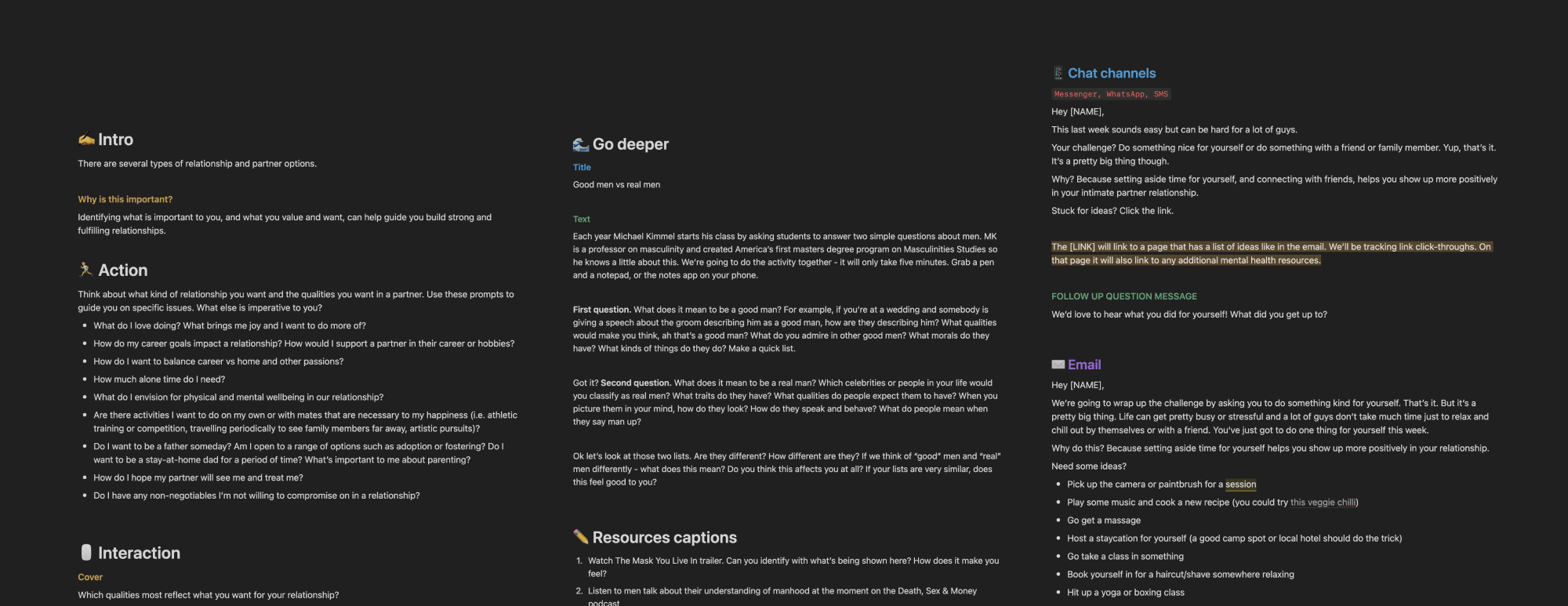
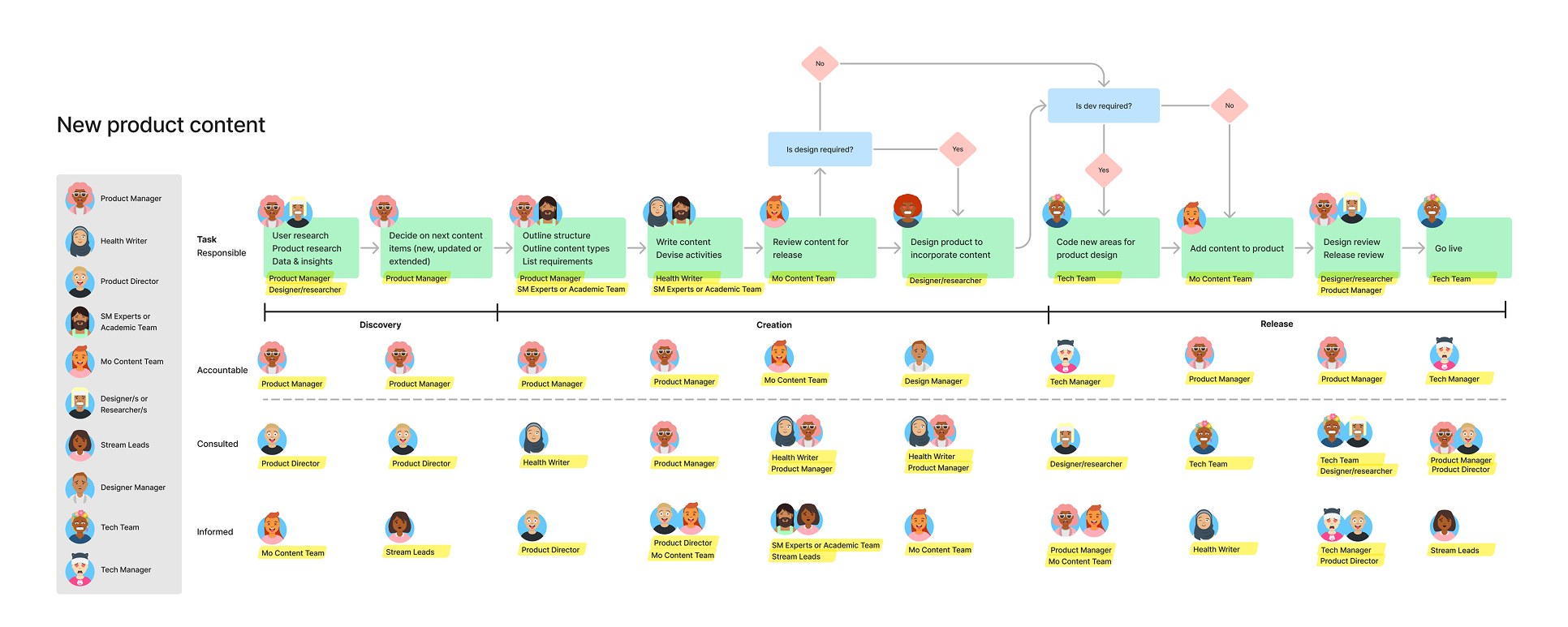

Research participant
This feels like something I'd come across scrolling on social. I’d for sure click on this if it came up as an Instagram ad. The content being broken up is very good, broken up quite well. Confirming your understanding of the content is really cool. Don’t know about people sharing this - guys tend to just share funny things, not useful things.
Producing a video show
From the validated ideas we narrowed down, one of the most expensive to pursue would be the development of a digital series that combined humor, vulnerability and hosts on a wide variety of topics within dating, relationships and separation. This was a very popular - and polarizing - concept. I wanted to test real world engagement and different formats with a tiny budget before any decisions were made to pursue this. I collaborated with an awesome Product Manager who was in the process of developing a significant mental health series for Movember and borrowed a couple of days of filming time with our resident expert. We then created clips with participants to test different formats of these to land on a decision and direction. Big thanks to Thomas, the excellent editor, for these trial cuts!

Research participant
Guys love videos Lis they really do. We’re not silly, we can read things, but are we really going to read it?
Designing the product
I carried out the shaping of the product, content flows, wireframes and UX before handing over to an awesome UI designer to take these ideas further. We could have tested the MVP on a low-code solution, but in order to meet brand organization requirements, we spent time here which resulted in a beautiful design by the team. We also worked together to create interesting engagement and ease of access. An important element of our work was exploring visual options for photography and videography: we knew we needed to be inclusive and realistic, but couldn't (and shouldn't!) spend tens of thousands on custom shoots at this stage. Instead, we heavily curated imagery and videos from stock, pulled them together for brand approval, and used these throughout.

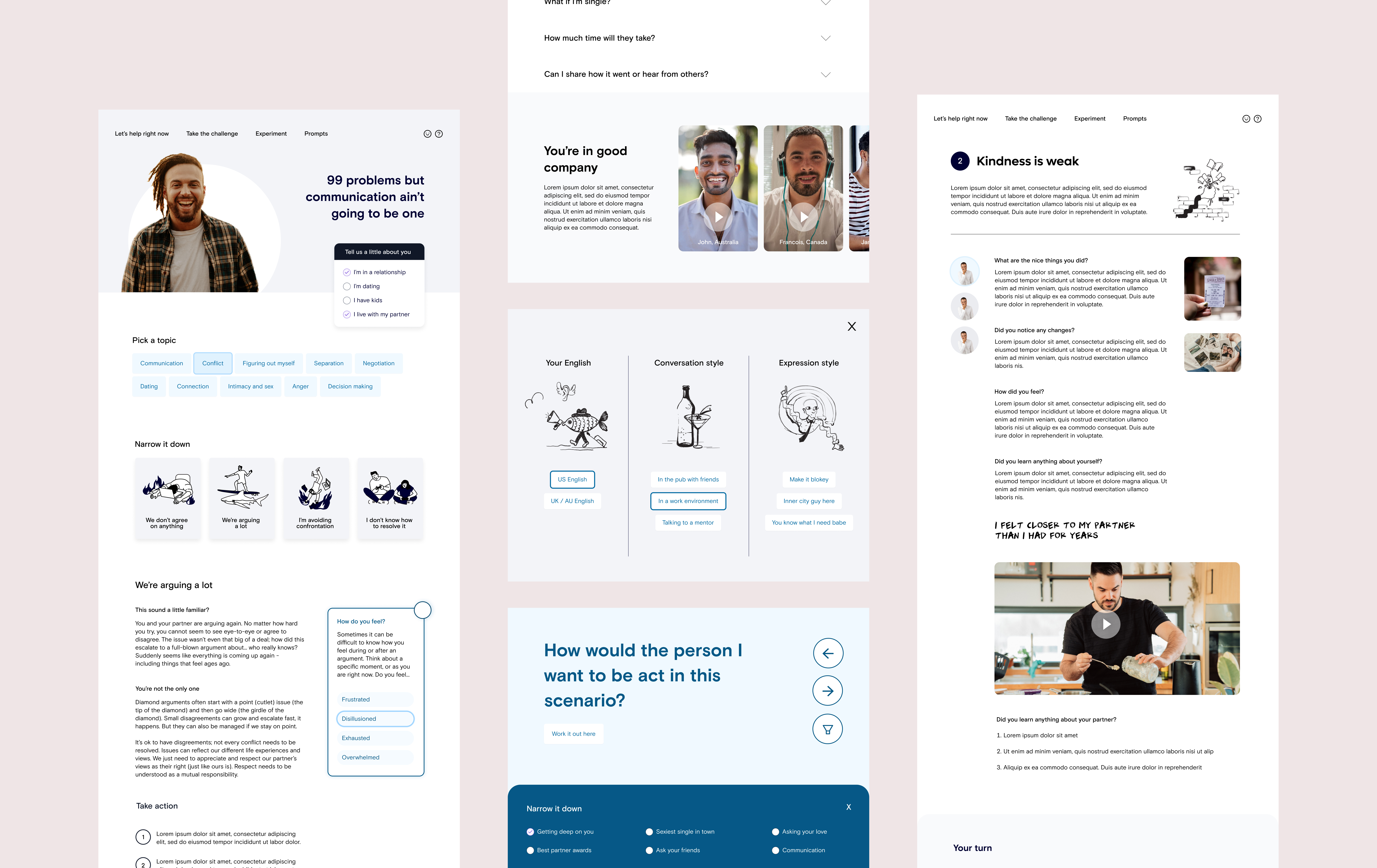

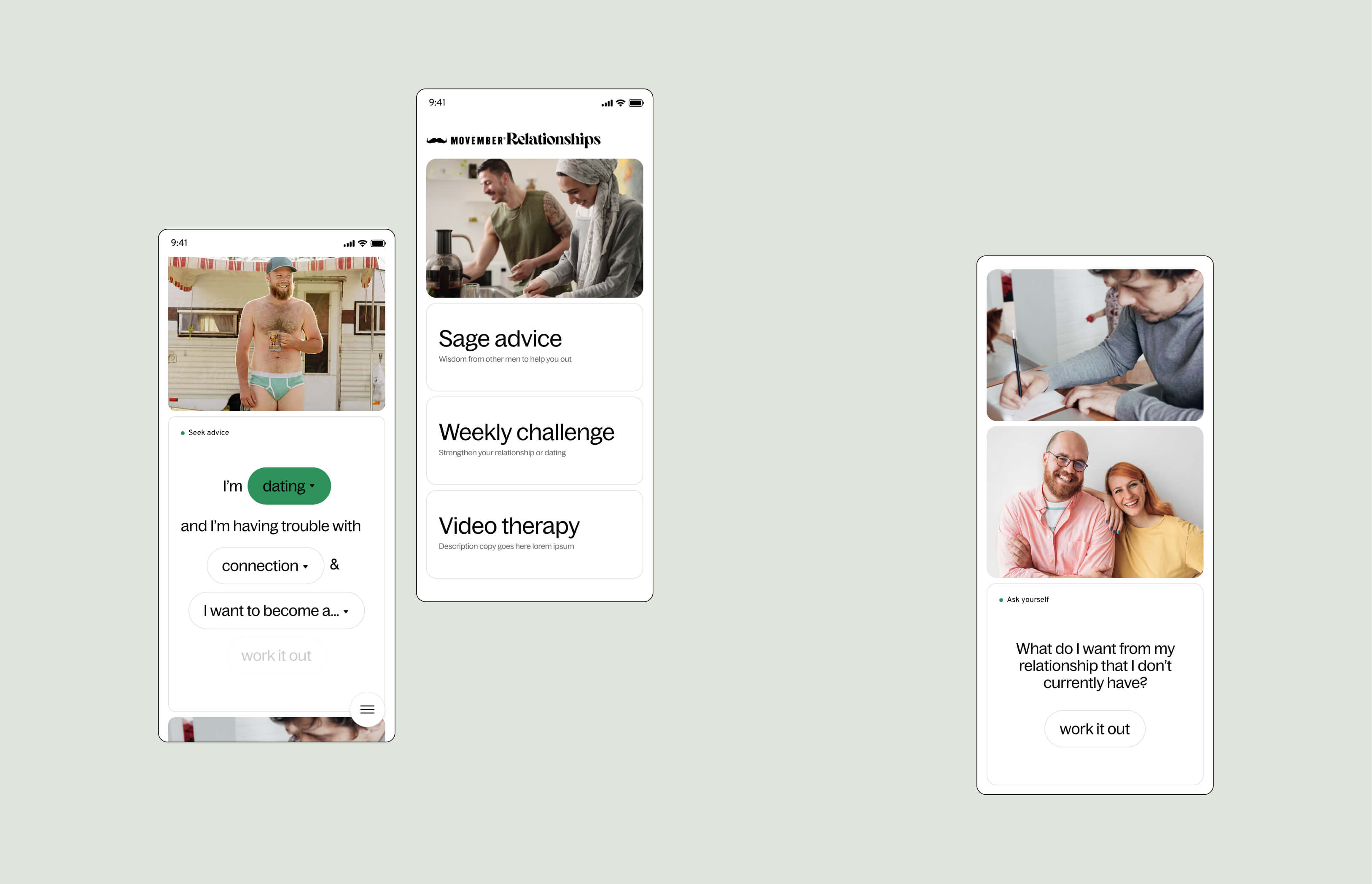


Research participant
I saw the bloke with the pot belly that I have so it’s for me. Saw the bloke jumping into the water too, so it’s for the average bloke I think!
Testing, testing, testing
With numerous tests in process and an MVP underway, I conducted more testing with the challenges, activities, channels and products themselves. We learned an incredible amount through this and what was exciting for me was the number of comments on the design, freshness, and inclusivity without it being prompted. In their own language, participants noted that themselves, their family members, their situations or their friends felt represented. This was very heartening.
Interestingly, from this round of testing came a big question of - how would I find this? How would I get here? Men themselves recognized they often relied mostly on the algorithm to serve up content, businesses, podcasts, and events in the region, rather than actively seeking them out or specifically following folks outside some of the well known or local ones. Turning to big, public campaigns (or distributed micro-influencers) and onto social channels was the next stage of the product, and these insights started to lead into how we might best develop this. With skill building, there is a small group of men taking active steps to look for this information or help. With many, it's a trigger that brings them to that place though - this project needed to work in the prevention space...inevitably, nearly always harder!

Positioning and messaging
To bring everything together, I worked on the positioning to highlight where we fit into the field, and how we should message this product. In charities, government and community services, the emphasis has been focused on corrective behaviors, often in relation to anger or domestic violence. This approach likely limited and stigmatized proactive engagement with relationship services, and tends to take on a tone of engaging only with men who might be perpetrating violence. We wanted to do this differently.
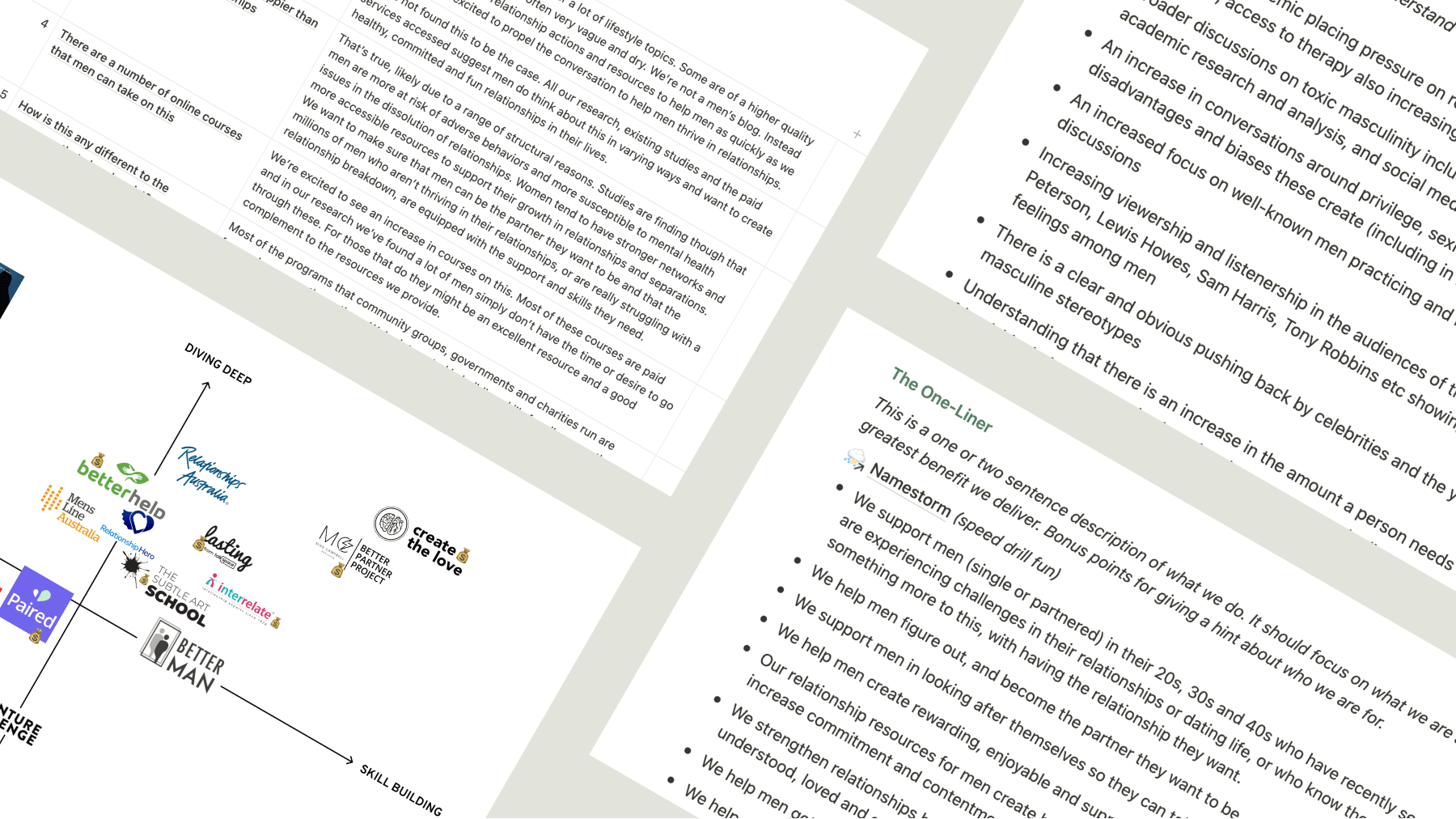
Making a plan for marketing
Marketing and campaigning were key components of this work and needed to be integrated directly into the product. Stage 2 focused on what we called Conversation Campaigns. Our user research showed that to engage men, we had to start the conversation publicly and then bring it to them, while also considering how women, often key conduits to men in health, might be involved without increasing their mental charge, something we wished to avoid. I researched the most effective campaigns and ads targeting men, including top-performing initiatives from Movember. From this, I developed a four-phase plan: conversation campaigns (including guerrilla marketing and partnership ideas), a user-generated challenge, and a dedicated social media strategy since much of the content was expected to be consumed there. This plan was then handed off to the internal marketing team for review, refinement, and execution as we began developing the UGC experiment.
Given Movember's huge breadth and network scope, I had a lot of fun brainstorming and crafting examples. Shown here is an example of this!
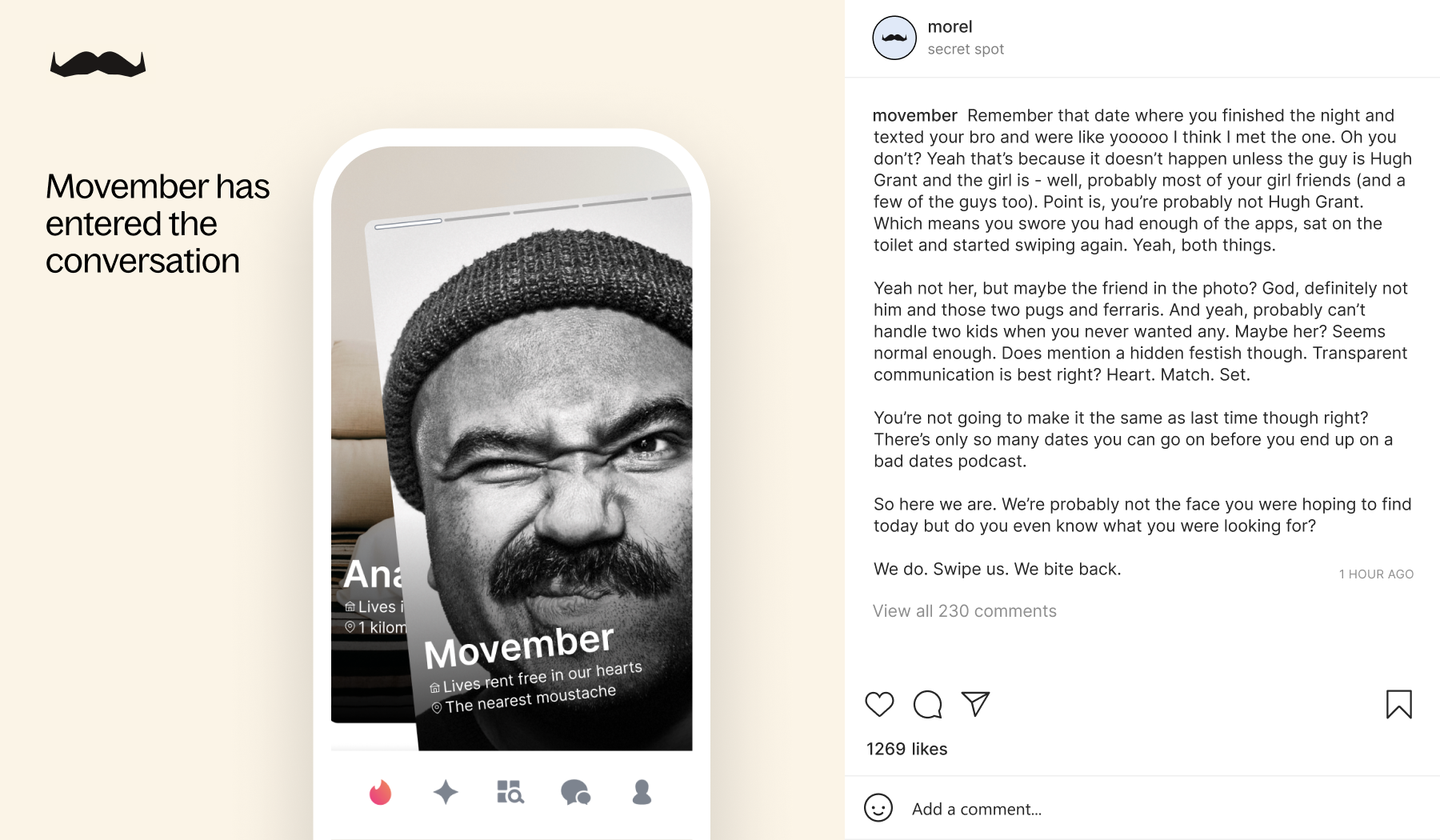
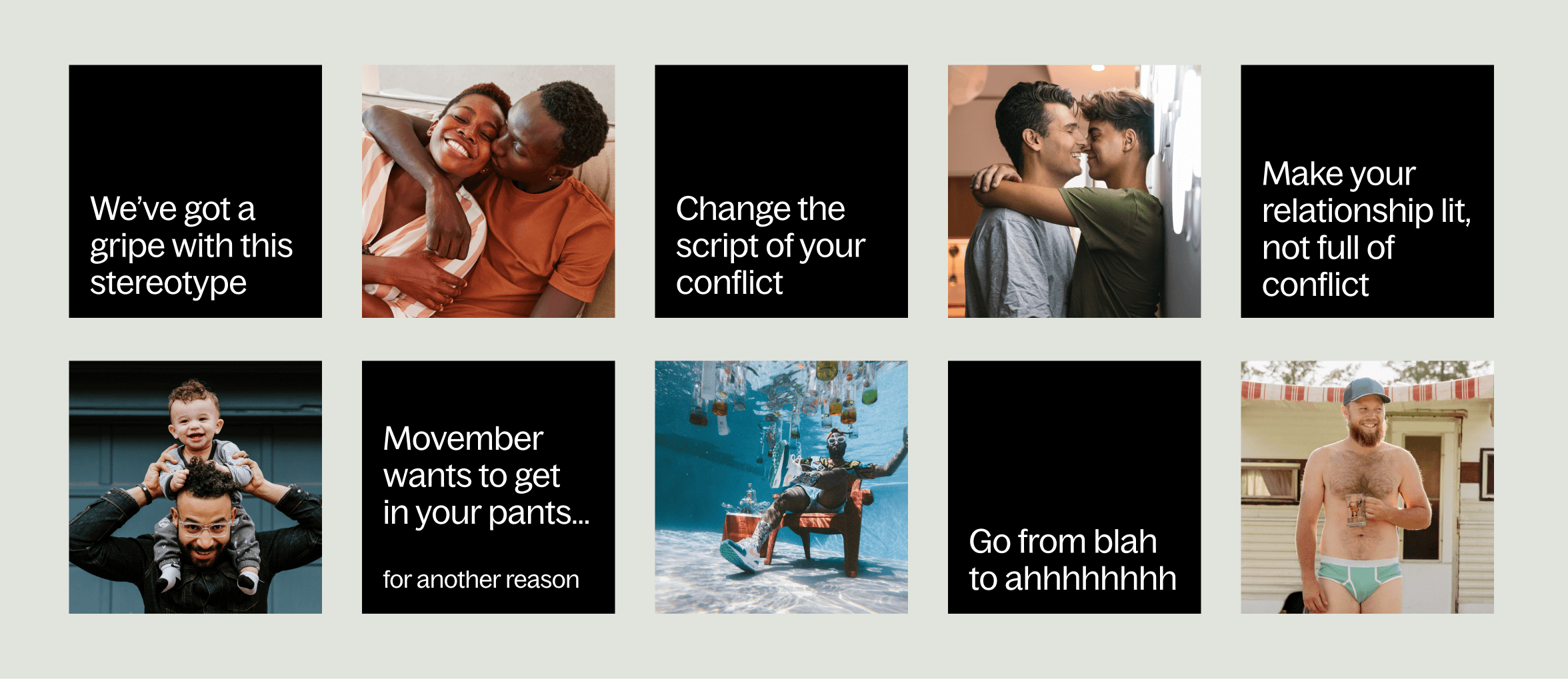
Monthly reports to keep things flowing
It's unusual to point out behind-the-scenes communication, dashboards, and reporting that happens, but at Mo we created digestible monthly reports so that all the teams, management layers, and experts across the organization could use as a quick status update each month. It was a core piece to refer to and highlighted what was working well, what needed more attention, and created a feedback loop into the internal process improvement team that was working on changes to make. It also supported team communications with funders coming onboard to back the work. The Product Director drove this idea from the start, and it helped me learn how enormously useful it can be in multichannel, complex environments.



Moving into the next phase
At this stage, we had learned a huge amount about the field, men, relationships and developing the first academic to real-life MVP within Movember. This came with unique challenges for an established and well-oiled organization, so it was useful to understand what we had learned. We pulled together a report for everyone to consume at various levels of detail, including layering product and org strategy. Big shout out to the Product Director and Global Head of Product for championing this to raise the quality of Mo Products to the next level in a growing product organization.
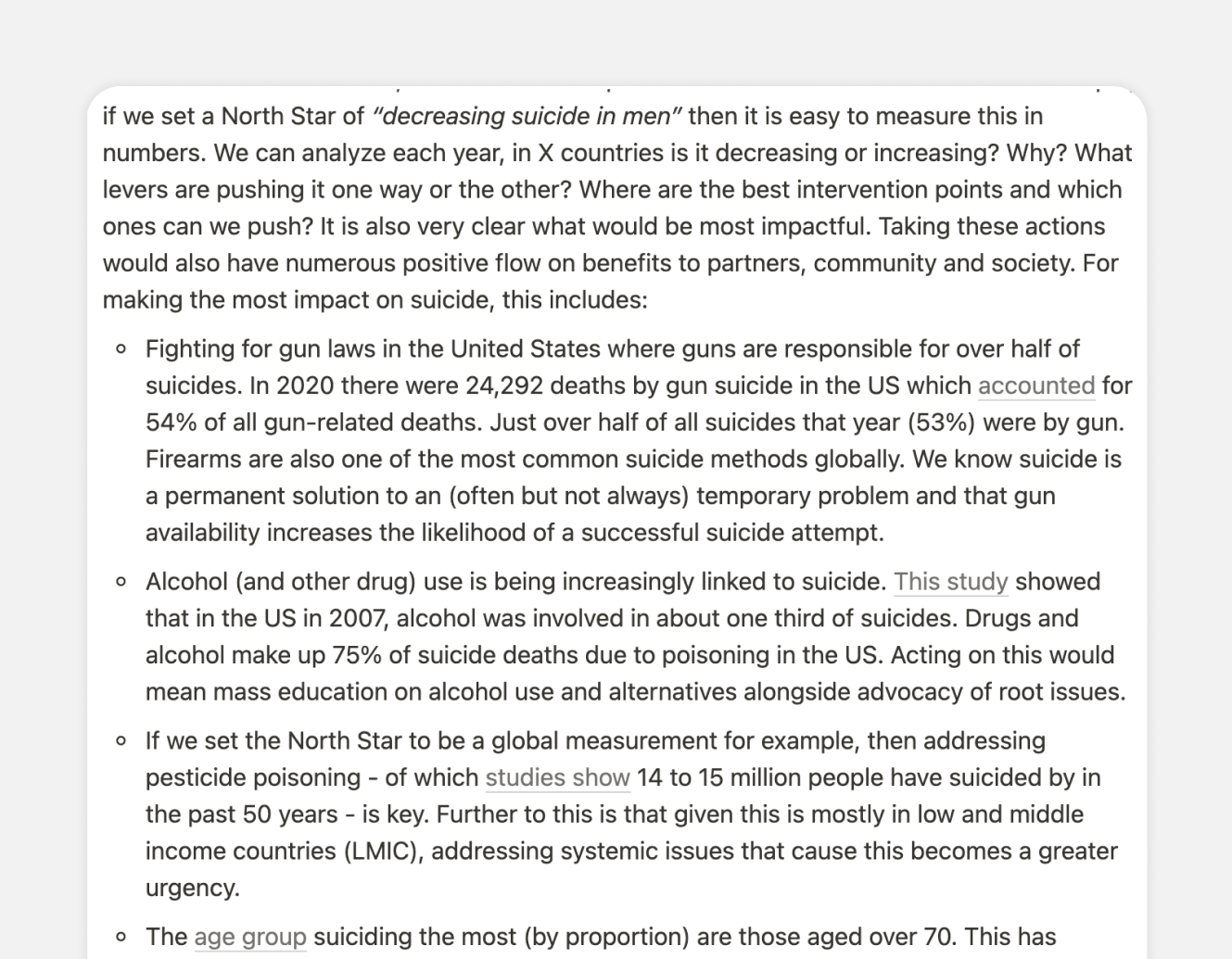
What's next
I wrapped up my time with Movember by outlining a six-month product plan and which unknowns still needed to be addressed with a higher priority as the product developed. I was incredibly buoyed by the enthusiasm of men for this project and left knowing there was a vacuum in this space that was being filled with incredibly needed conversations and action as we assessed the status of relationships post-pandemic and how we spend our days together.
My many interviews left me with the impression that though we may not utilize the right words, and though some of the global influences might be unhealthy and there definitely remains a number of strong stereotypes particularly in partnered relationships with children, we have grown in emotional maturity, and most of us would find it useful if there was more wayfinding and opportunity to have discussions about the shape of our lives, our relationships, and the futures we want to create. In many instances, I felt that what we see in mainstream society every day - whether comedy, campaigns, charities or corporations - was often lagging behind what people were doing, trying, feeling, thinking or dreaming in the real world; in our cities as much as the open country.

